Philosophy
English is the hot new programming language
It's the best time to learn coding, no matter what your profession is.
I made a resolution for 2024 to learn Ruby on Rails, a controversial web development framework famous for maximising developer productivity. In the business of building and growing products, I wanted to be a self-taught developer too.

The goal behind my trite, cliched new-year resolution was to get to a point where I could build apps in a weekend. I have been day-dreaming about a state where—I get a shower-thought, I write code, and in 2-3 hours, I have a production-grade software that’s ready to roll. An end goal of shower-thought driven software engineering was my final objective.
After a brief affair with no-code apps where I tried to achieve this agility (Bubble, Softr, Glide, Framer), I realized that most of these apps were platform-dependent. You couldn’t export your code. You had more lock-ins, and lesser customisations. It was this meme all over again:

I realized that hard-coding was the only way. So I dived deep into Ruby on Rails this year. And to ingest and digest it as much as I can, I’ve been racing past the Learn Enough tutorials by Michael Hartl for the last two months. I also ended up binge watching screencasts from Ryan Kulp’s Founder Hacker course for an added perspective. The first red-pill moment was when I built my first ruby script to solve my own scratch on making wikipedia imports into Obsidian easier, I started gaining more technical sophistication to make quick things and ship it for myself.
My progress in hacking my way around, learning about enough coding to be dangerous, and also racing through different steps of the web development (Git, IDEs, HTML, TypescriptCSS, JS, Ruby, Ruby on Rails) would have not been possible without asking the most stupidest of my questions to ChatGPT as a newbie, amateur, rookie developer.
From the Founder Hacker course, where Ryan Kulp builds a Ruby on Rails app live on Youtube
I’ve found bugs in the code, copied the error without understanding into ChatGPT and then again back to the IDE to make changes and see if it works. And I’ve realised that the barrier for designers to code and bring their designs to life is getting narrower over time. You’re literally ‘spellcasting’ to get your code out, by just chatting with the LLM.
From tl;draw to Diagram and Galileo AI, we’re seeing instances where prototypes are being built at the speed of the ‘mouth’. Every type of programming becomes a conversational design piece – text to text, text to video, text to code, text to game, text to UI, text to 3D prints, etc.
Just unveiled at #Config2023: The first-ever demo of Genius by @diagram, now part of the Figma team. pic.twitter.com/0KxQViOz64
— Figma (@figma) June 22, 2023
The moment is here! Galileo AI is opening up sign-ups for our private beta.
— Galileo AI (@Galileo_AI) October 24, 2023
If you want immediate access and to start generating designs for free, reply to this thread to skip the line.
Be more like Alex and use Galileo AI to crush your deadlines. 👇 pic.twitter.com/VwnFp0GtSB
Over time, I’ve realised that I am not actually learning Ruby on Rails. I’m learning a way to ask around and figure out in plain English. I’m building stuff by prompting. To name a few:
- A simple web UI
- A telegram chat for meal planning
- Ruby on Rails UI components adapted to TailwindCSS
LLMs are the closest thing in the real world to magic, and prompts are the magic spells. Just like spelling wingardium leviosa, you’re typing carefully curated prompts. We’re seeing examples such as Promptbase where prompts are secret magic-spells being traded on the marketplaces. (I'd earlier shipped Prompt Hero to ride on this wave)

With the rise of LLM-backed coding assistants, I’m not even copy+pasting into ChatGPT questions anymore. LLMs are being tightly integrated into the codebases through these coding assistants. I’ve been recently using cursor.sh, an AI-native IDE. They can now read, explain code, document code, write code, autocomplete it, diagnose issues, and even perform arbitrary IDE tasks. Everything is pretty cool, right?
In the final stage of developer productivity, AI-native IDEs seem to be the direction where the world is heading. English is the hot new programming language, and I’ve been coding in English using these AI-native IDEs.
We’re now seeing a new breed of design engineers, who could both design and ship code at the same time, improving the production cycle between building and shipping software.
the “design engineer” will evolve to represent the blurring lines between design and code and more of us will become one
— jordan singer (@jsngr) February 12, 2024
it will be both a designer than can now code thanks to AI
and an engineer that can now design because of AI https://t.co/XnWGtY6eWQ
"I think design engineers will be the most sought after role this decade"
— Ridd 🤿 (@ridd_design) February 12, 2024
- @davidhoang https://t.co/pXuLMnFjHG
It somehow seems like a great time for anyone, be it an architect, product manager, roadside cartoonist, sociologist, to be a design-engineer first. If all we need is english to code and build products, then who is stopping us?
Everyone can now do shower-thought driven software engineering if all that’s needed is crafting good prompts.
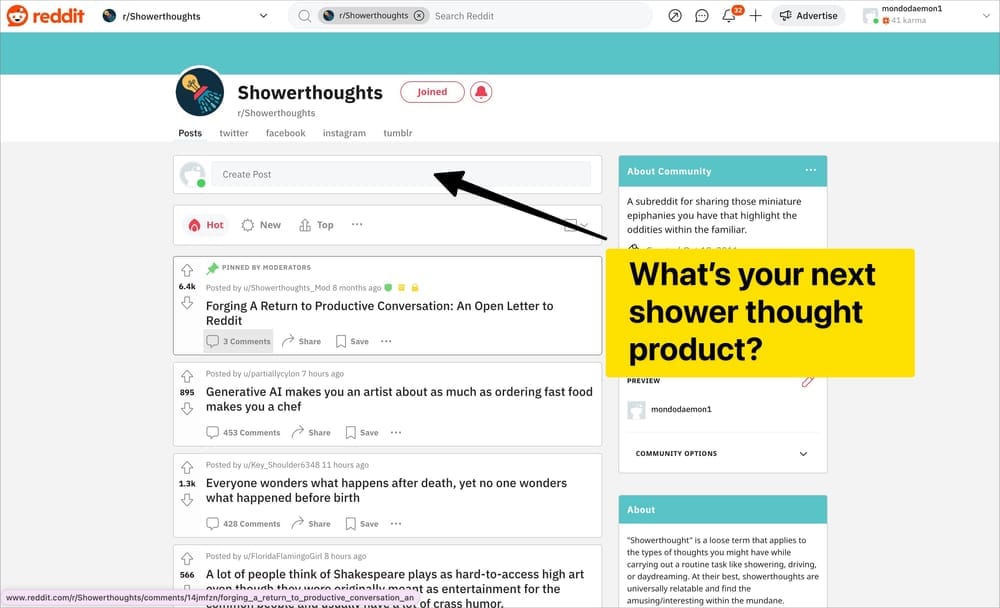
Update: Devin enters the chat.
How might we help children invent for social good?
What surviving an attack from a man-eating tiger has taught me about invention and rural entrepreneurship
I stayed in a tribal village in India for a year teaching children leadership skills through design thinking. Here’s a story behind my non-profit initiative and how we’ve impacted 1200+ children from 3 rural areas (also a short segway in which I was chased by a man-eating tiger)
Can children invent for social good?
We expect kids to do kids-related work, but what if they stepped up as leaders and gave back to their community? This was the guiding question behind this social initiative.
As an impact initiative, we followed the open innovation framework for structuring our work. Systemic change does indeed take time. 1-2-3 or even 5-10 years to have something tangible. Most of the social innovations got stuck at prototype/scaling stage which we wanted to avoid.

I stayed with the locals in the tribal village of Maharashtra, India to understand the context. To bond with the villagers, I actively involved as a teacher, helped with the jaggery production and rice harvesting. The day ended with copious notes from all the observations.

Lobhi village was quite remote and secluded. Lying amidst a thick forest belt often frequented by leopards and tigers. This is a picture that I took while being chased by one of these man-eating tigers which visited our village during summertime (yes, I live to tell this story)
While working with rural children closely, I was baffled by their creativity. Less was more!
They build upon innovative ideas using fewer resources. They played with flowers, fruits, clay and even dried leaves. The play didn’t require plastic toys or some fancy 3D printers

Yet, at the same time, their creativity was underutilized. 70 percent of India’s workforce resided in rural areas but only 20% of the graduates were workforce ready. The ethnography studies led to the formulation of our social initiative.

2+ years of experimentation in the form of pilots in rural schools helped us to carve out this program. We aimed at providing leadership skills through design thinking. The program was divided into three phases (unconditioning, critical thinking & design thinking)

Why design? Because design is not just about making cute little drawings, but so much more. You could think about problems critically and solve them. We believed in the vision of nurturing such young changemakers through design.
As a product of the traditional educational system, you had to do a lot of ‘unlearning’ to look at problems differently and to tackle them. The first phase of our program did exactly that. Letting your mind unlearn, and to let your creativity juices to flow more freely.

We also observed a lot of students getting stuck with creative block to build and explore. So we designed various challenges to create an enriched visual library of mechanisms, structures, materials and applied science/maths for the kids
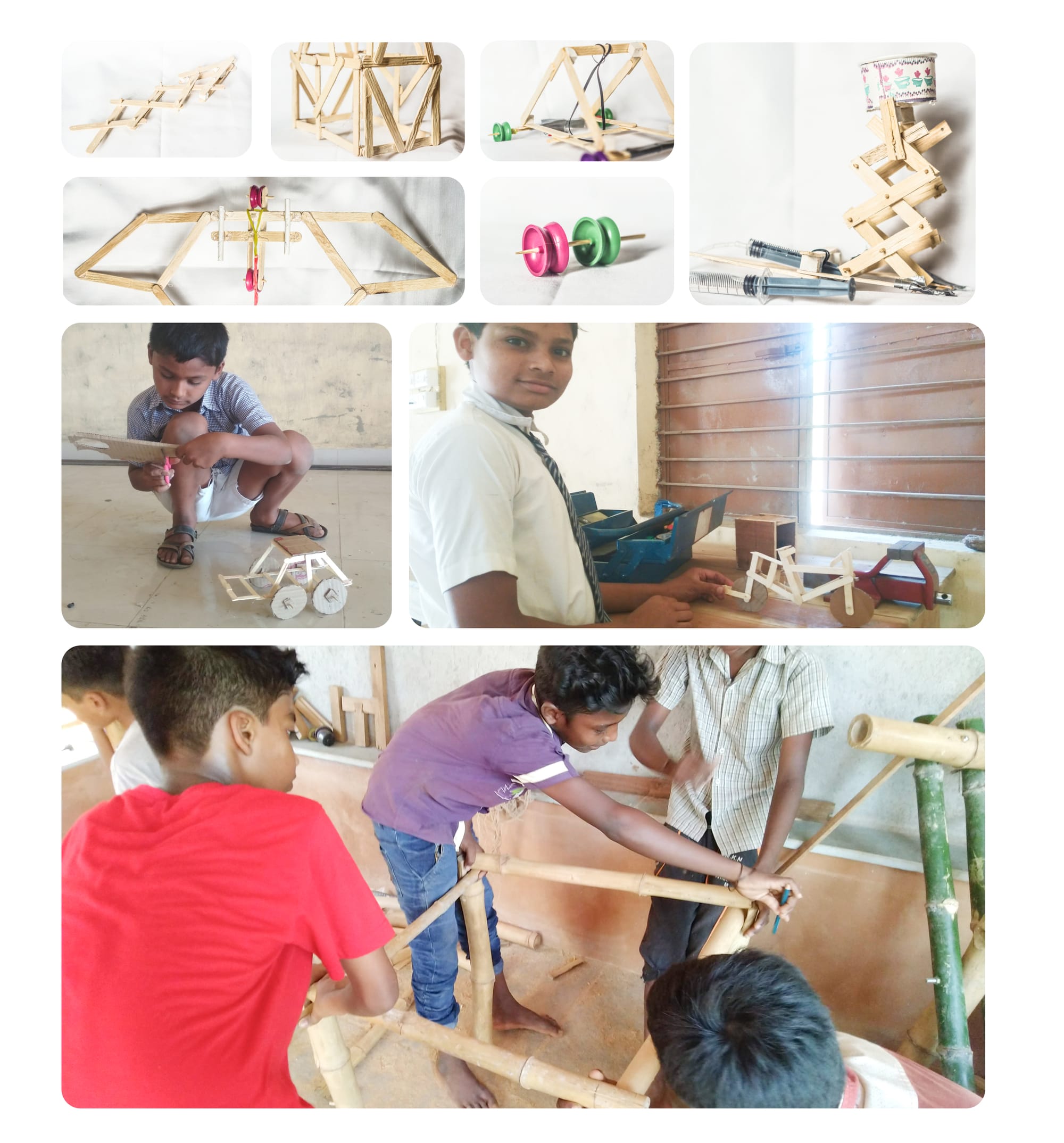
This is one such example from an activity which we designed. The challenge was to build a bridge that could hold their own weight using popsicle sticks
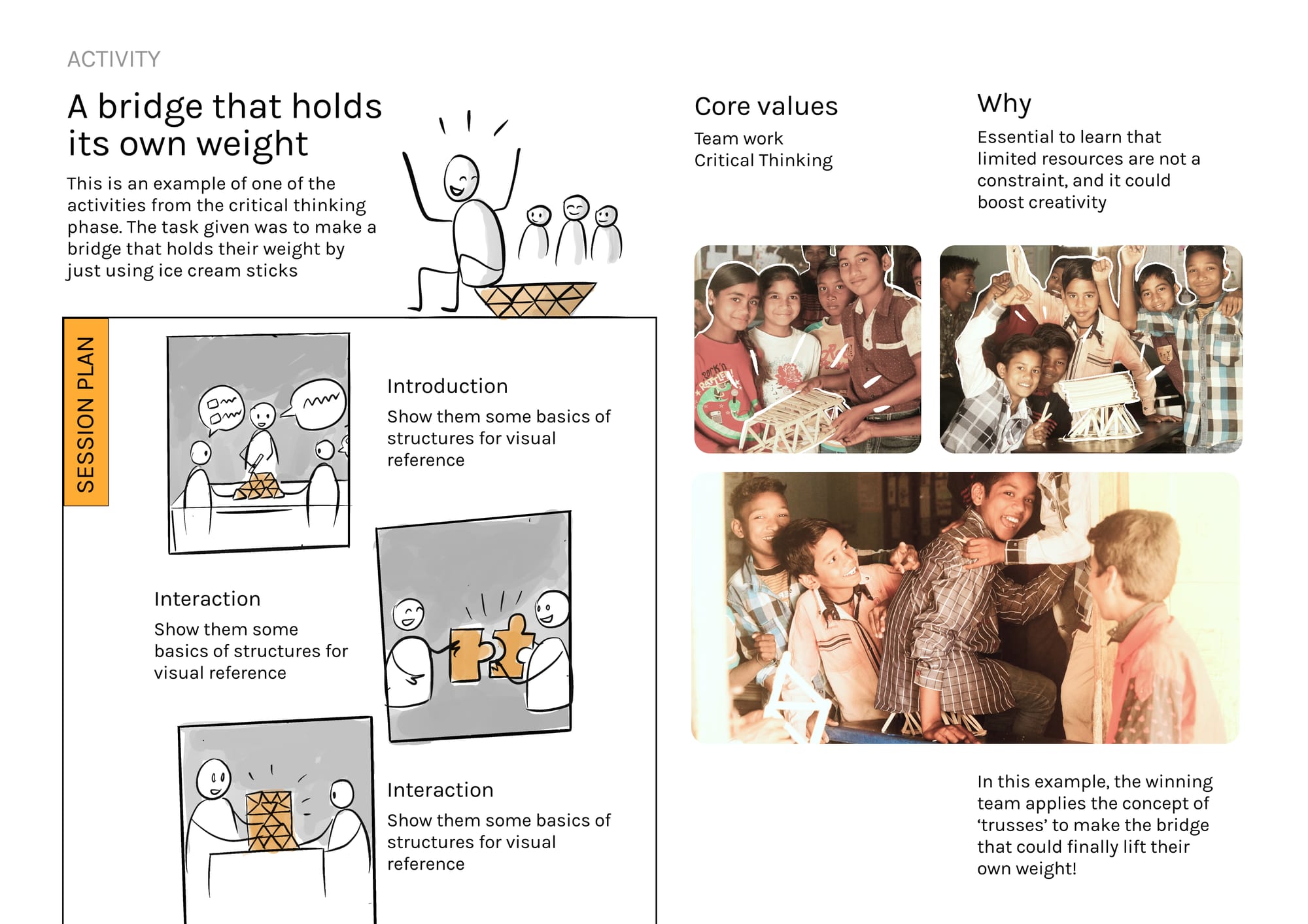
This is another such example from the design thinking phase. The students were asked to go for nature walks and document their observations. In this manner, the core values of observation, empathy and team work were reinforced among our children.

The vision was focused towards building self-reliant student leaders from the community. The OECD Learning Framework 2030 was followed to make sure that the knowledge, skills and values were aligned through our curriculum.

The tap (money) shouldn’t run dry, even if it is for a good cause. So we systematically injected funds through external grant agencies and crowdfunding support. The financial capital was leveraged along with social capital (media, mentors, hackathons) to scale impact.
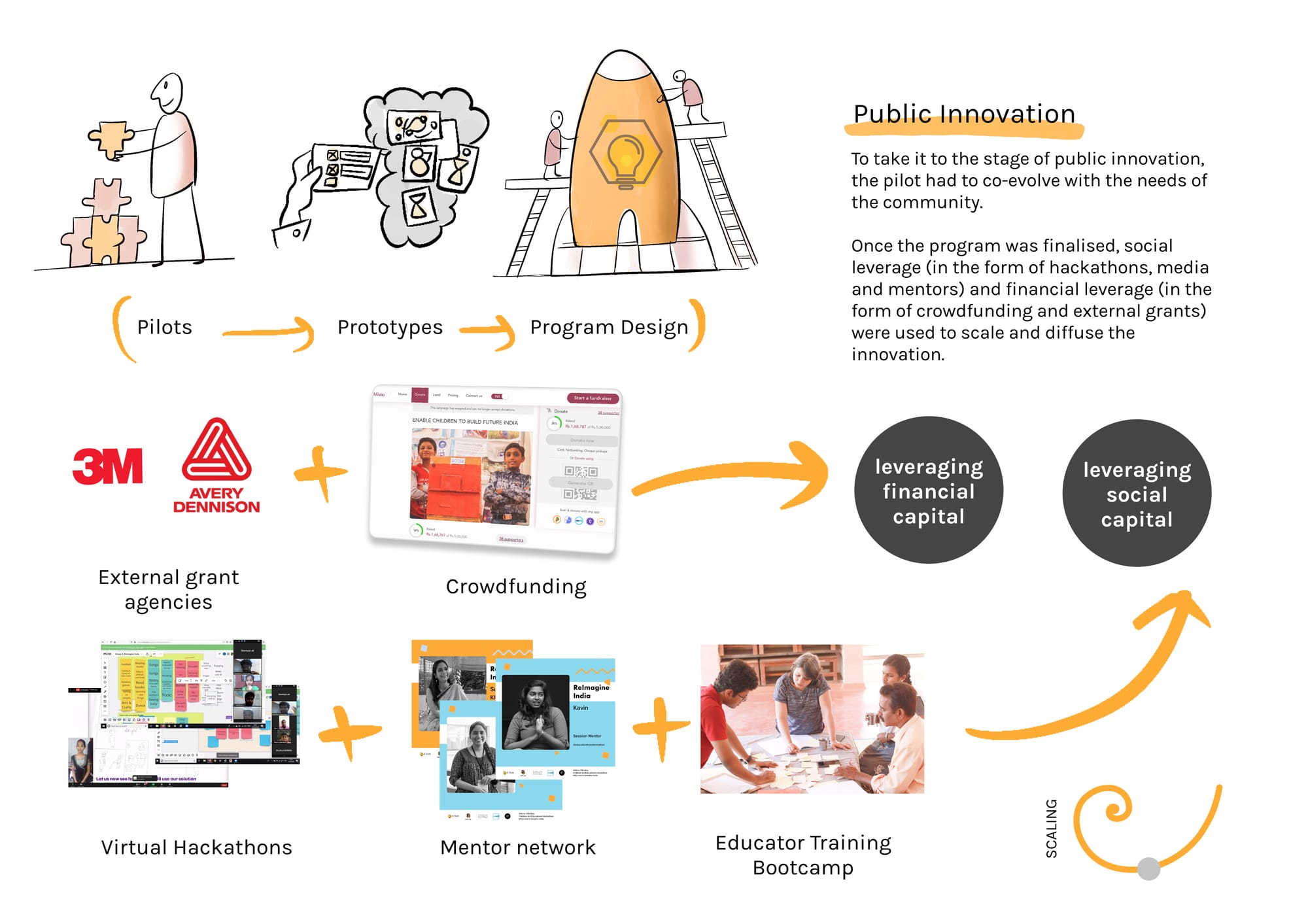
Will take you through some examples which I personally consider as a ‘systemic change’ for the communities.
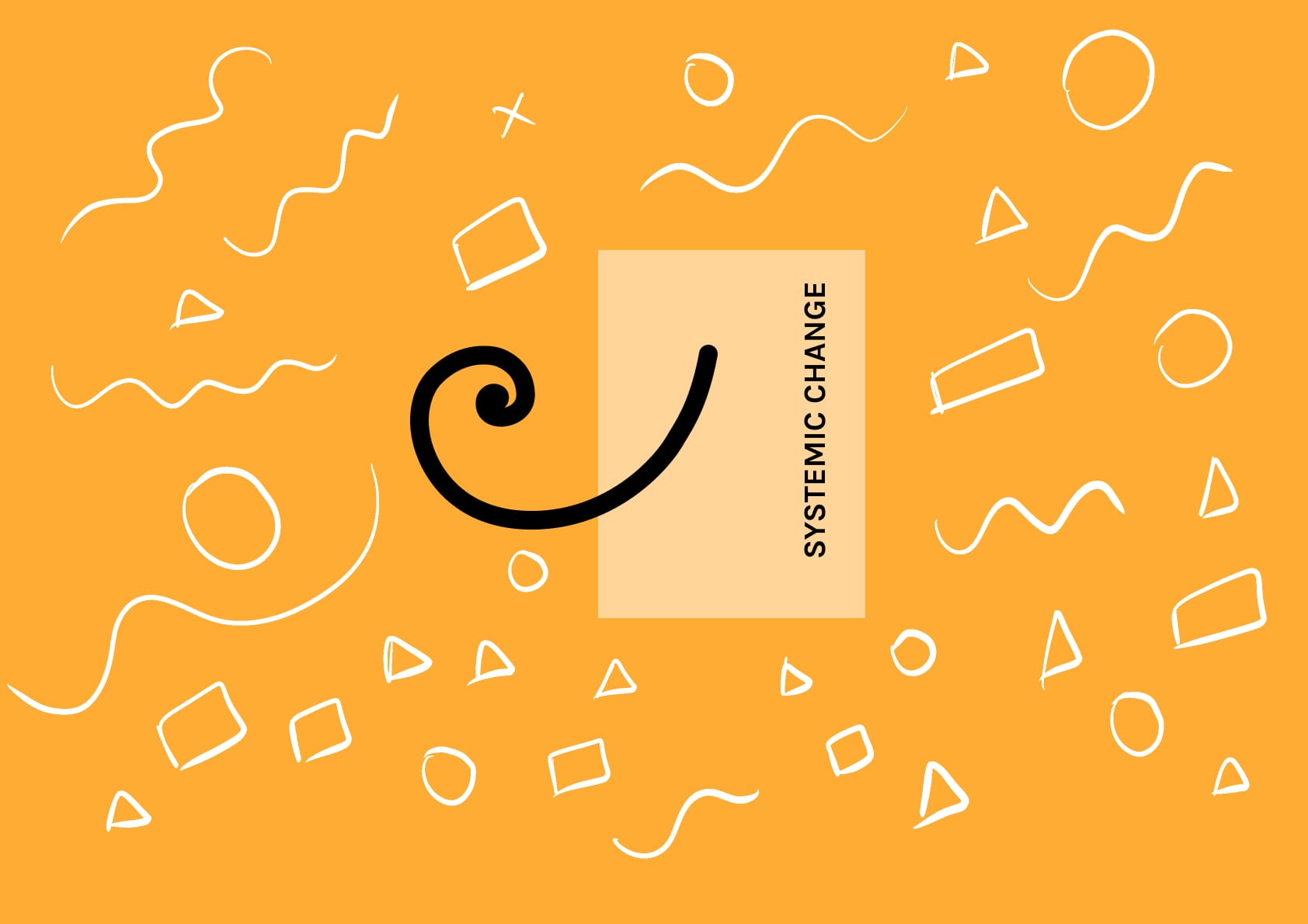
Our students build 12+ innovations over the course of time. The beauty of these innovations were the simplicity and resourcefulness and the ‘jugaad’ (frugal mindset). Local solutions developed locally by the locals
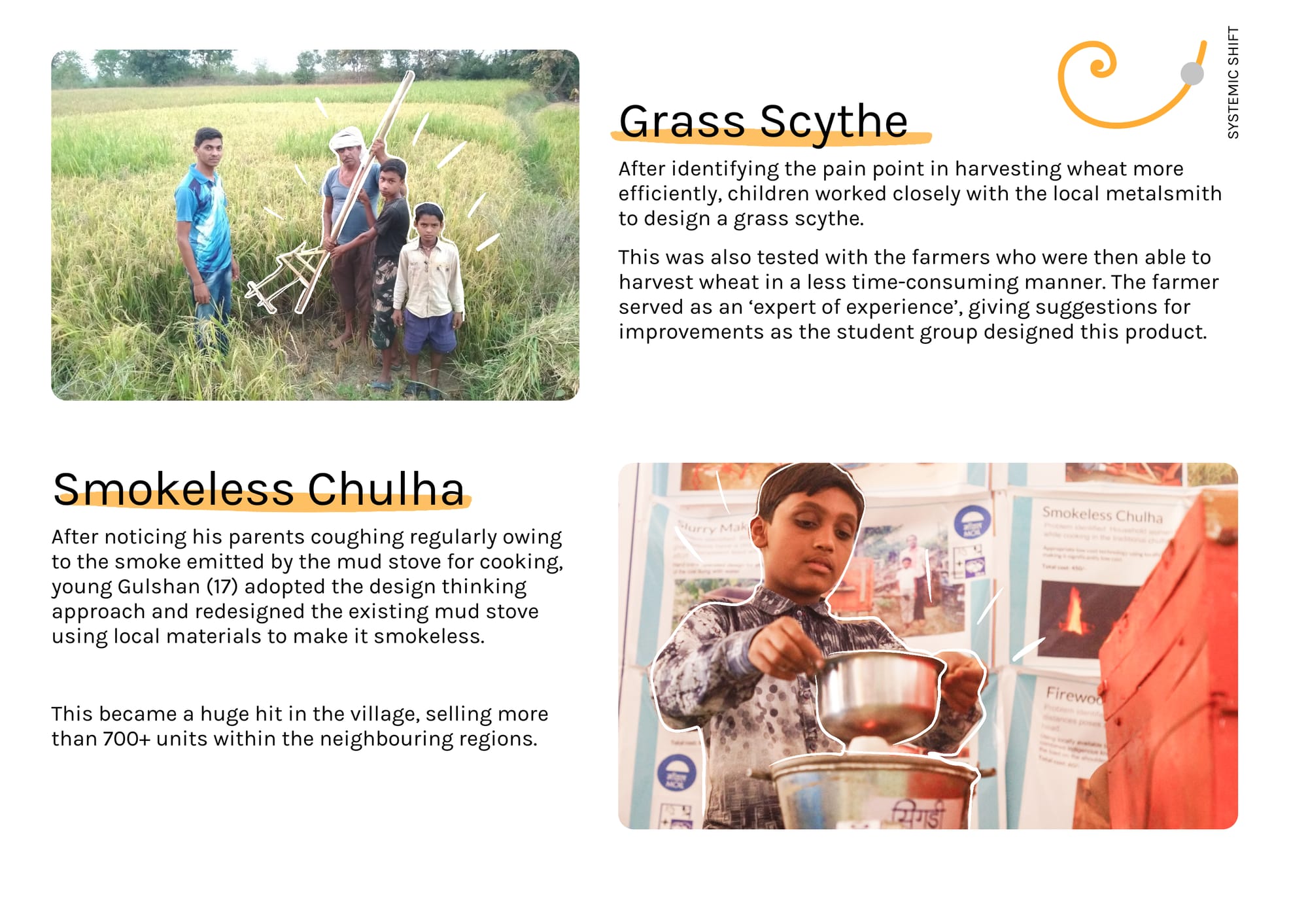
Among the innovations included a pole climber (risk free climbing of poles by electricians), smokeless chulha (smoke-free mud stove), grass scythe (for wheat harvesting), leaf plate machine (local production of sustainable leaf based plates) etc
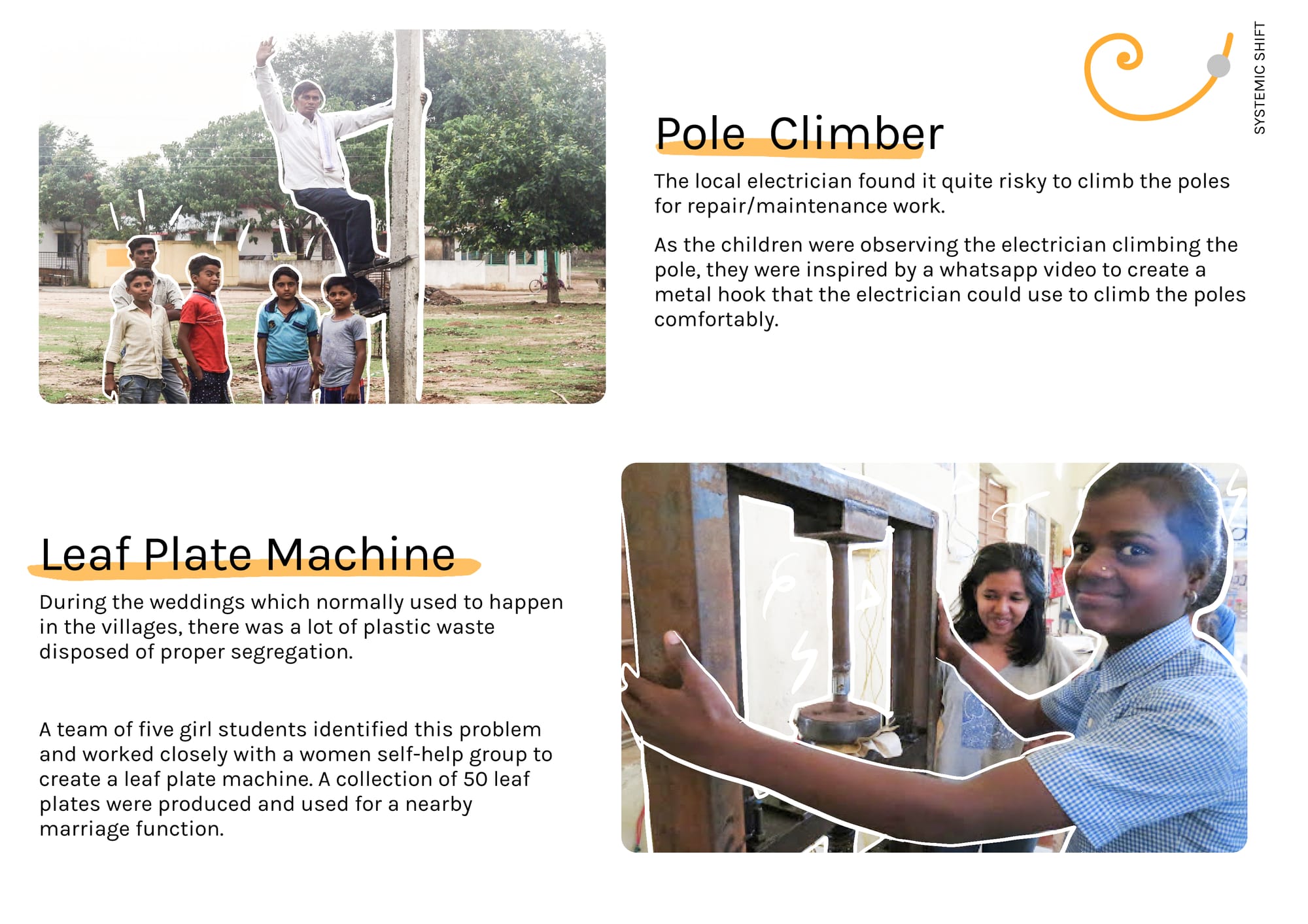
Firewood carrier: Helping farmers transport firewood through a bamboo based carrier. Slurry Maker: Clog-free slurry for biogas plants intended for cooking. The kids went through the design thinking process and developed these innovations
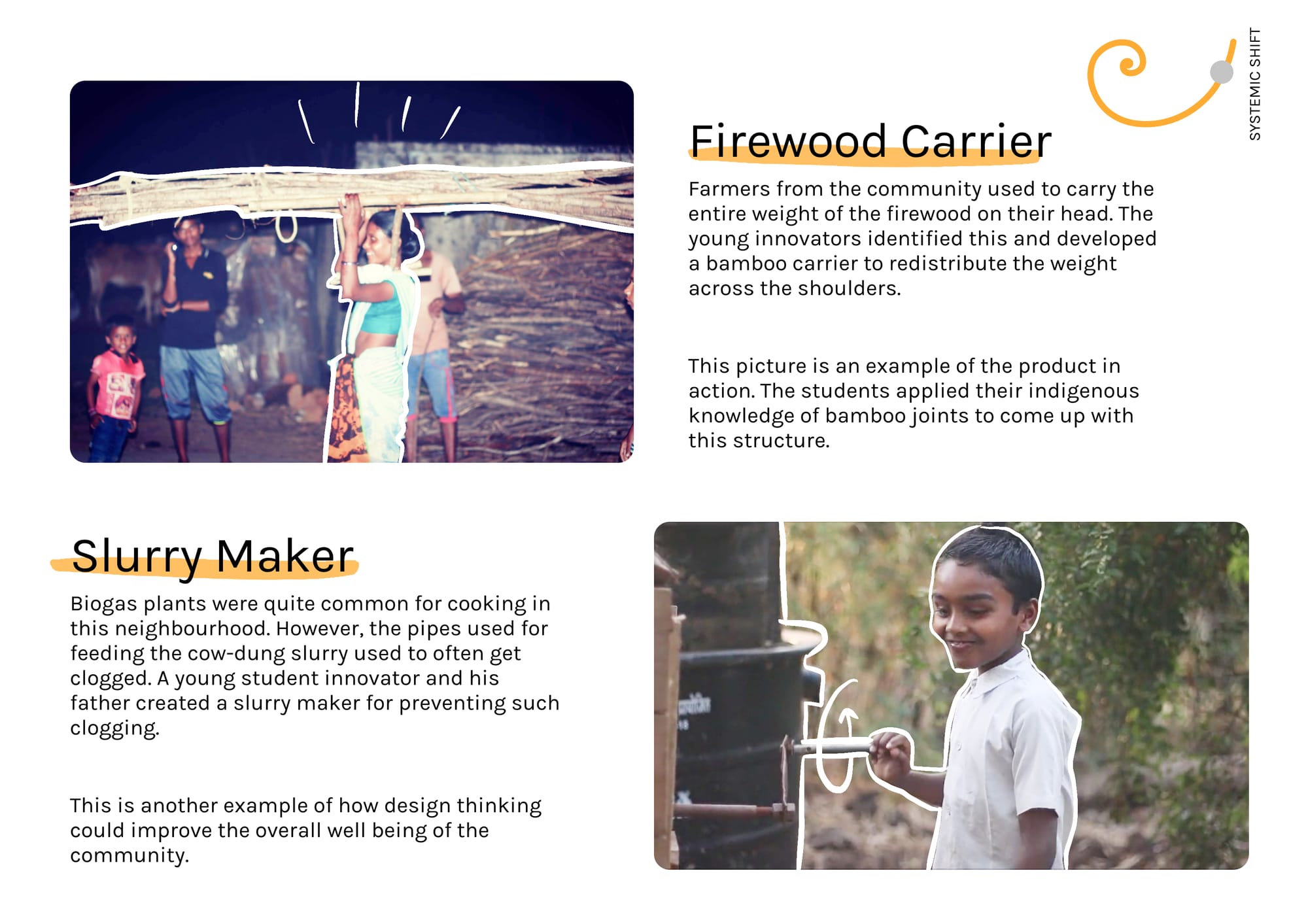
After seven months of lobbying, a one-of-a-kind children-led makerspace was established!
This provided the students with a platform for expressing their creativity. The students also actively involved with the community (farmers, artisans etc) and co-created solutions with them
A couple of our student innovators also got scholarships and were award recipients for their impact work. All these observations were published as a book titled ‘Rural Design Toolkit’. This was meant to encourage all our young grassroots innovators :)
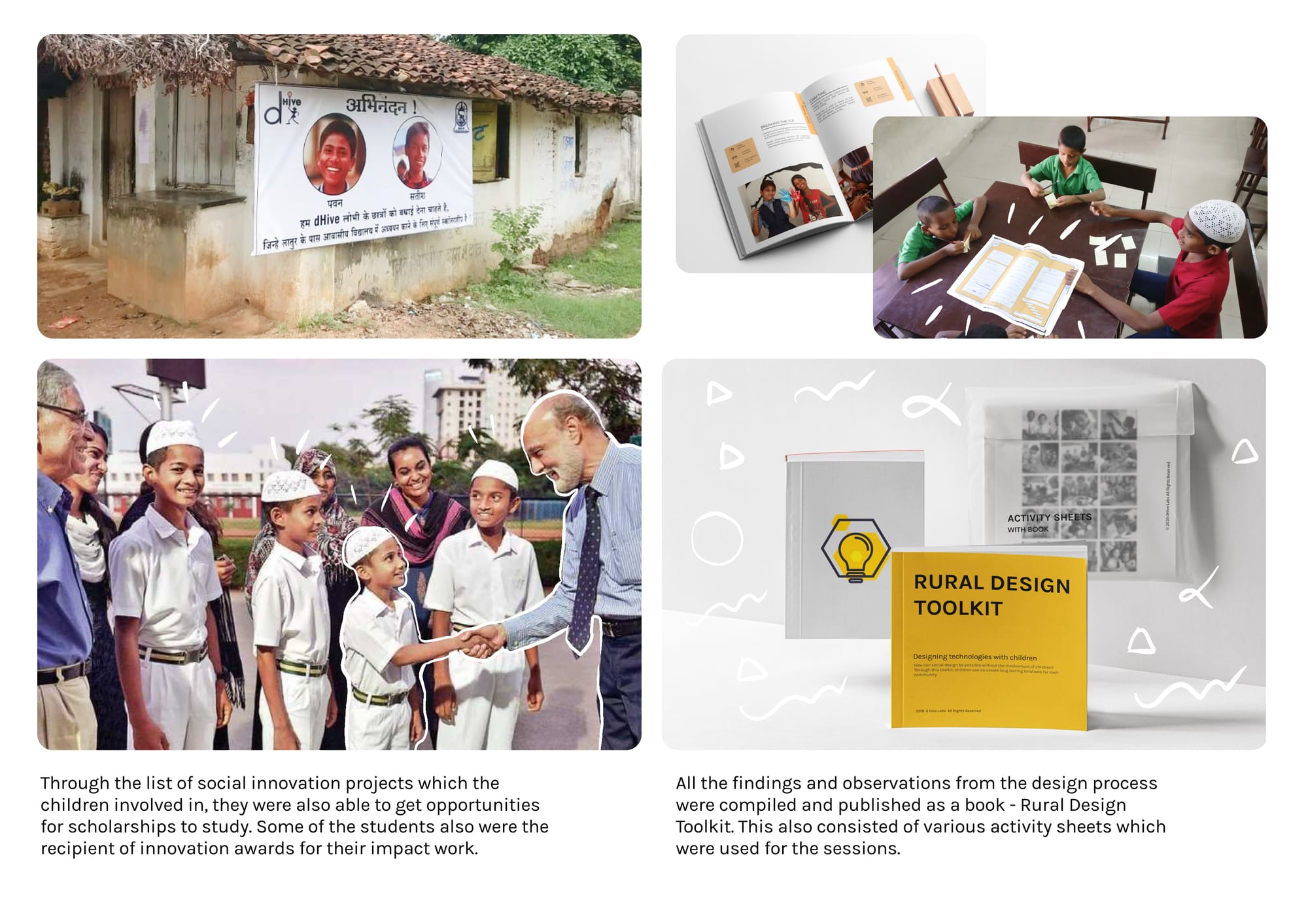
One of the innovations (smokeless chulha) also achieved significant maturity for taking it forward in terms of production. A group of 8 women members formed a team and were trained by the student innovator to take it forward as a social enterprise.

The systemic shift is still quite a hefty word. More than the innovations and the enterprises formed, the mindset shift which we observed is what we are the proudest of. From ‘What can the government do for us?’ to ‘What can we do for the community?’
Design methods are life jackets. Not straight jackets.
Structures, whether they’re processes, frameworks, or plans, are excellent tools to navigate complicated problems. They bring efficiency, reduce ambiguity, and offer defaults.
However, when dealing with fundamentally complex problems, applying structure too early can lock in outdated notions. Because structures tend to ossify. As more team members join after the structure is in place, they may not understand the underlying thinking. They start adopting processes and frameworks while being unable to answer why they exist.
Templates are ready-made blueprints. They’re convenient, no doubt. But they often end up replacing the hard work of thinking about the problem.
In the worst cases, templates are square pegs forced into round holes. And they can sometimes lead to what I like to call “performative solutions.”
You’re doing the steps because they’re there, but are they really solving for the actual job-to-be-done?
Here’s a guiding principle to help you think about processes:
Process should formalize how things already work. It should fit the problem naturally, not impose itself.
Misapplied structure can actively obscure the underlying dynamics of a problem. This hinders real understanding, as people must now overcome the inertia of the structure to discover how things truly work!
You see, people will tell you not to reinvent wheels.
I disagree.
There’s no substitute for thinking about a problem bottom-up. And if you find there’s no need to think about the problem bottom-up, you’re— either not working on the right problem, — or, underestimating the complexity of the problem.
Making something from scratch lets you see all the little details and nuances that templates might miss. And the process of figuring things out on your helps you build real courage and conviction in your solutions.
This also ties into the adverse effects of gyaan-culture.
The journey from complexity to simplicity is often a hard-fought one. Experienced practitioners arrive at simplicity after having waded through complexity. It’s only after having their hands dirty all this while that they are able to distill their wisdom into clean insight.
However, their audience misinterprets this templated simplicity as an all-encompassing prescription, leading to all sorts of trouble.
The simplicity presented is like the visible tip of an iceberg, while the underlying complexity remains hidden. This misunderstanding can and often does lead them to passively accept templates and avoid thinking independently.
So, think of any framework as a lens that guides thinking, not something that replaces it. No single lens is universally applicable, and overreliance on one will only create blindspots.
Tobias Van Schneider in his blog talks about a new way to think about building modern software—
The majority of content and material things is not made to last anymore.
The same is true for online tools.
Startups aim to capitalize on trends and our desire for convenience, launching new apps and services every day to solve the same problems.
We are so accustomed to something new and seemingly better around the corner, we don’t commit to anything anymore. Not to clothes, to music, to online tools or physical products. Companies and publishers recognize this and see a shortcut. If you don’t care about the quality, they have no reason to either.
But the blame is on us as consumers as well. We are insatiable, easily bored, easily distracted. If your app isn’t delivering new features a mile a minute, we’re out. If a new app springs up that offers the same thing in a shiny new package (and it will), we’ll abandon your app and jump to the next one.
We’ve lost our sense of pride as producers and consumers.
The heirlooms you receive from your grandparents are treasured, passed down generation to generation. A silk scarf, beautiful in its worn softness. A piece of furniture, as solid and stately as the day it was built. A physical toolbox, carefully polished and organized after decades of use. Today, we’re satisfied with the item that will arrive soonest to us from Amazon. Where has our pride and care gone?
This is what inspired our vision for mymind. Everyday we ask ourselves: How can we take the beauty and care of a physical product that lasts generations, and apply it to a digital product?
Similar to an Eames chair, designed with love, purchased after careful consideration, placed in a prominent spot in the home, passed from family member to family member. We’ve always worked in the digital world, but we seek to build digital products similar to quality physical products of past times.
Consider a leather journal. You can touch it, smell it, hold it, feel the texture. It gets worn with use and that makes it more beautiful. You can hand it down. It’s cherished by those who inherit it.
Consider your vintage Ray-Ban glasses. You don’t throw them in your bag where they’ll be scratched, or leave them lying around where they’ll easily break or be stolen. You wear them, carefully clean the lenses and put them back in their case. You might have another cheap pair of throwaway glasses you use now and then. But you’ll always have your Ray-Bans. They were designed to last, to be loved.
While it may not be as rewarding in the short-term, we want mymind to be that kind of product.
We don’t want to stress about keeping up with other tools (many of them here today, gone tomorrow) and shipping new features to satisfy “users” who demand it. We don’t want to try to meet every need and create a monster of a product, dinging bells and tooting whistles until we spontaneously combust. We want to achieve the purest form of our tool and let it continue to be that. We want to be here 10 years from now. We want to create, if possible, the digital equivalent to the iconic chair, sunglasses or notebook. Something you proudly care for, polish, return to, count on year after year. Something you own for a long, long time.
The desperation for newness is a sickness of technology.
It’s a disease perpetuated by algorithms, desire for immediate satisfaction and the craving of dopamine unfulfilled by unhealthy lifestyles.
Refusing to succumb to that illness requires saying no. As creators and business owners, it requires forgoing the temporary rush of users riding one tool to the next. It requires coming back to our original mission, over and over again, every time we make a decision about our tool.
And we hope it leads to something meaningful. A tool built to last.
Importance of Why
He who has a why, can endure any how
When it comes to task management, a fundamental principle stands tall: explain the reason before the details of what and how.
By letting others know the why behind a task, it facilitates faster completion.
Recently, I had a pressing deadline for an urgent activity that needed immediate attention. I had to convince my designer teammate to create a quick mockup in less than a day, even though he had other high-priority tasks on his plate. It was a P3 task in a sea of P0s.
To make it work, I simply shared the reason behind the task before diving into the specifics. It motivated my teammate to prioritize the assignment without any micromanagement.
In the end, it all boils down to focusing on the reason, and the tasks will naturally follow suit.
As Nietzsche once said: He who has a why can endure any how.
Quality Ideas Trump Execution
What creativity faucet can teach us about generating quality ideas
‘’What might seem to be merely the initial step — deciding what to work on — is in a sense the key to the whole game’’ — Paul Graham
A good start when it comes to product building is half the work done.
While running the Build program as a Program Director, a four-week program for folks to go from a fleeting idea to a full-fledged product, we ran it in a building cycle that went from (a) ideation, to (b) validation, and then (c) building the product.
We consciously skipped a lot of processes which involved defining the customer, problem statement, conducting user interviews and all that jazz. Primarily because the aim was to build a side project that could be built within a weekend, which made the cost of building quite less. (We didn’t actually tell them to skip all these steps, only to do that after having built the product they were imagining)
Now with the advent of no-code tools and ChatGPT (of course), it has become easier to build a great software on the internet.
Which makes it even more important to: have a quality idea.
People may have heard me use statements like ‘’the idea is everything’’ and while hyperbolic, there is a huge amount of truth to this. A weak idea on something your audience find un-interesting will perform badly regardless of other ways you bring ‘’quality’’.
So how do we bring extra quality to idea selection?
- Allocate more ‘’thinking time’’ to ideas
- Allocate more research time to ideas
- Truly look for something unique and innovative
- Brainstorm a greater volume of ideas
- Have an elimination criteria for your ideas
I use my 100-10-1 framework. I will typically brainstorm 100 ideas, whittle them down to my best 10, and make the one I am most confident in. Julian Shapiro talks about the Creativity Faucet, a process of arriving at good ideas merely by the method of elimination.
I call their approach the Creativity Faucet:
Visualize your creativity as a backed-up pipe of water. The first mile is packed with wastewater. This wastewater must be emptied before the clear water arrives.
Because your pipe only has one faucet, there’s no shortcut to achieving clarity other than first emptying the wastewater.
Let’s apply this to creativity: At the beginning of a creative session, see through every bad idea that comes to mind. Instead of being self-critical and resisting bad ideas, recognize that you must see them to completion.
Bad ideas, by the way, are often the clichés your brain has been overexposed to.
Once bad ideas are emptied, a surprising thing happens: better ideas begin to arrive. Here’s my guess as to why: Once you’ve generated enough bad output, your mind reflexively identifies which elements caused the badness. Then it becomes better at avoiding them. You start pattern-matching interesting ideas with greater intuition.
This works because it is easier to look at something bad and intuit how to make it better than to make something good from scratch. The human brain isn’t wired for spontaneous ingenuity, but it is wired to detect what’s wrong with the world. Is the song too high-pitched? Lower the pitch. Does the story have too many lead characters? Remove a few.
Spending more time thinking of ideas. Even talking about these ideas with your pals. As you have more and more good quality of insights, you start thinking from a position of abundance instead of being in a position of scarcity.
As designers, we’re always asked to vouch for the user’s needs above anything else. But if the company takes a hit, all of our efforts might end in vain.
To solve this dilemma, this note from Dan Winer comes in handy—
You were hired to build a business.
Show your value using the benefits over features method:
Don’t talk about the “quality” of your design.
Talk about its impact.
Don’t present a “cleaner design”.
Elaborate on how it reduces cognitive load and boosts efficiency.
Don’t stop at “improving the user experience”.
Explain why it creates long-term profit.
Don’t sell accessibility as “the right thing to do”.
Talk about the potential of the untapped market.
Don’t offer “intuitive navigation”.
Show how it accelerates the path to purchase.
Don’t only focus on “inclusive imagery”.
Describe how it enhances brand perception and broadens your demographic.
The goal is to solve problems for our users and create value for them through our designs.
But design is the how; building a business is the why.
Use these tips to position design as an essential investment for the business, linking your expertise directly to the company’s growth and success.
It’s all about the right framing. The right solutions come at the intersection of user’s needs and business needs. That’s the sweet spot.
This thought was inspired by the book Design Expertise (Lawson & Dorst, 2009) which includes an interview with the architect Ken Yeang where the author mentions: “I give every new member of staff the practice manual to read when they join. They can not just see past designs but study the principles upon which they’re based”.
In other words, what would be the ethos behind your own unique design practice? When every designer is different in their own way, what would be one’s own philosophy of practice?
This took me on a very reflective journey, digging into my very own practice back in India, and also with the Masters program here at TU Delft to understand the underlying practices and principles behind my very own way of doing design.
Writing the key principles, has in a way, made it explicit, my very own 11 fundamental principles behind my current workflow. Truest to the design process, the principles are still iterative and not exactly written on stone, however, this is a good start to thinking seriously about one’s own practice manifesto.
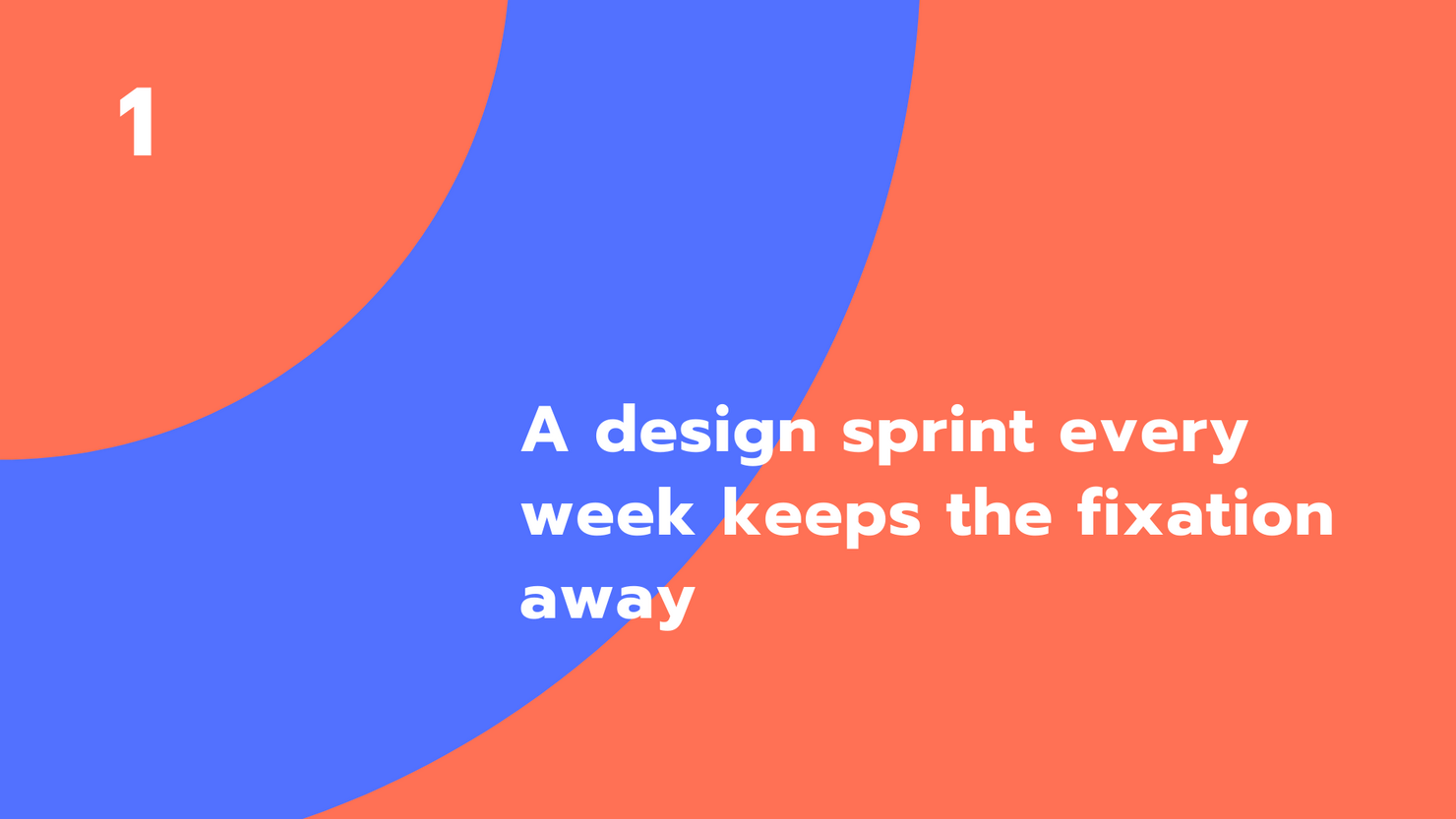
It’s always the case (at least with me) when the projects somehow magically gets completed in the last moment, few minutes away from the exact deadline when you wonder, and marvel at how stunningly true this law is. Commonly called as the Parkinson’s law, it quotes that work expands so as to fill the time available for its completion. ^4d1fad
You have five days to complete a project and it gets over after four weeks, 23 hours and 55 minutes (or somewhere around this borderline). But surprisingly so, when you have seven hours to complete the same task, you could still do a decent job at completing it in time. The time pressure does something magical to you.
To steer clear, I started having self-imposed deadlines which I started taking seriously when I realised how having milestones every week through sprints were making the design process more effective. Through this scrum approach, things were getting done more quickly than expected. The week finally wraps up on a better note with a standup meeting where the team discusses critical blockers and milestones achieved over this span.

As Naval Ravikant, Founder of AngelList puts it, human beings are not meant to be like cows, grazing on grass all day. We are closer to carnivores, the lions in this aspect. We train hard and we sprint and then rest for sometime until we are all set to sprint again. This quote summarises how the mental model of the design sprint should be perceived as. It is not about the number of hours put in, but the expected deliverable that comes out at the end of the weekly design sprint that matters the most. This helps overcome fixations of most kinds.
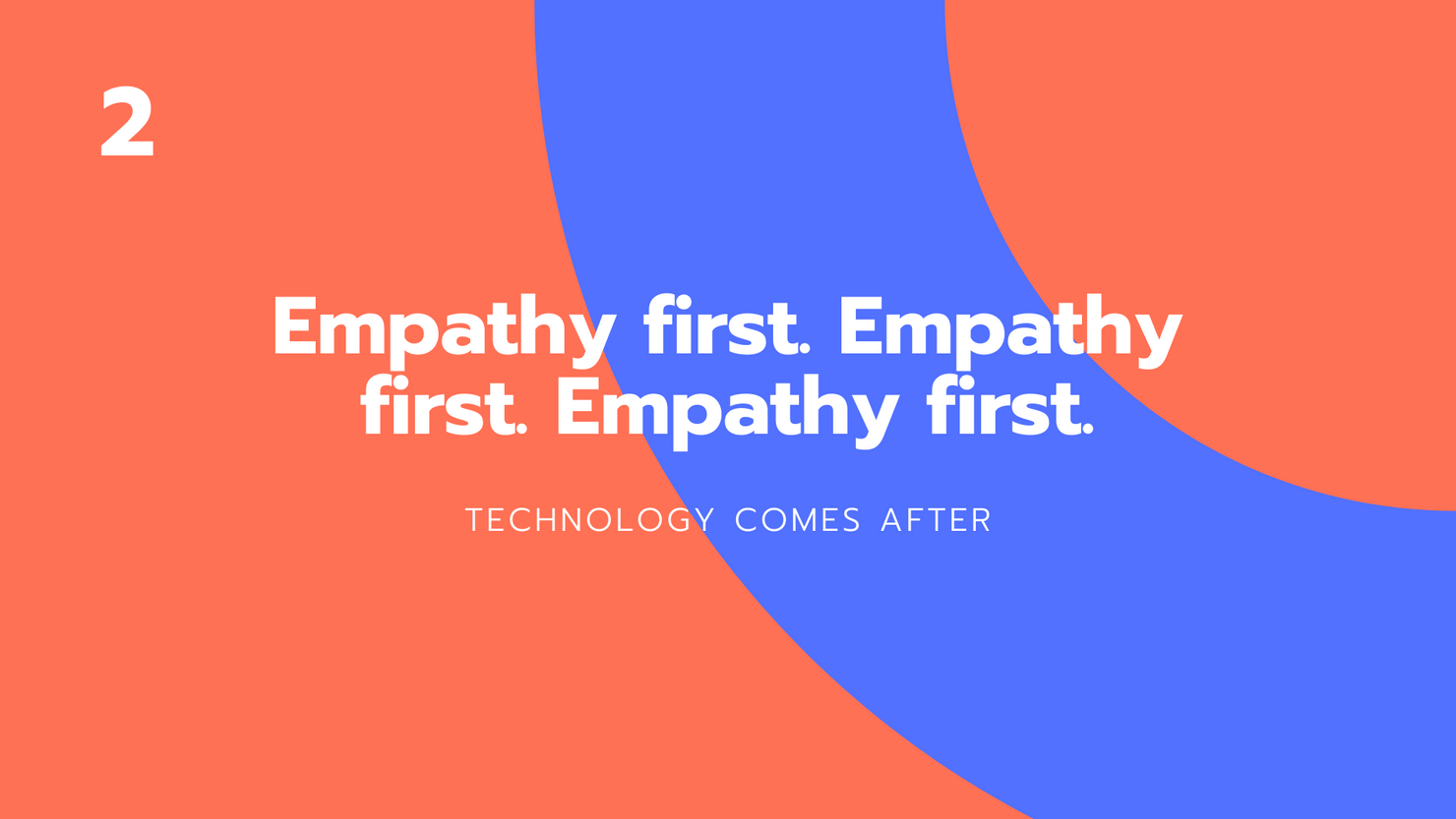
As a designer, we become more of an interlocutor, connecting various nodes, stakeholders in the form of engineers, users, scientists, governments and other stakeholders, to synthesize information in order to come up with a creative outcome.
In this journey of dealing with wicked problems, one might get lost assimilating information, be sidelined or might even find it difficult to comprehend. Empathy is that bulletproof shield that keeps one from continuing the journey. Adam Grant in the Tim Ferris podcast mentioned his workflow to achieve high-volume high-quality work done as follows, “When you feel unproductive, it doesn’t mean you’re lazy. Its often the sign that you haven’t found what makes the project interesting to you or meaningful to others.”

Once we empathise with the individual we are designing for, assimilation and synthesizing information becomes easier, as now we have the intent to get it done.
Empathy should come first. Grasping technology required to tackle this problem would become much smoother once priorities are set.
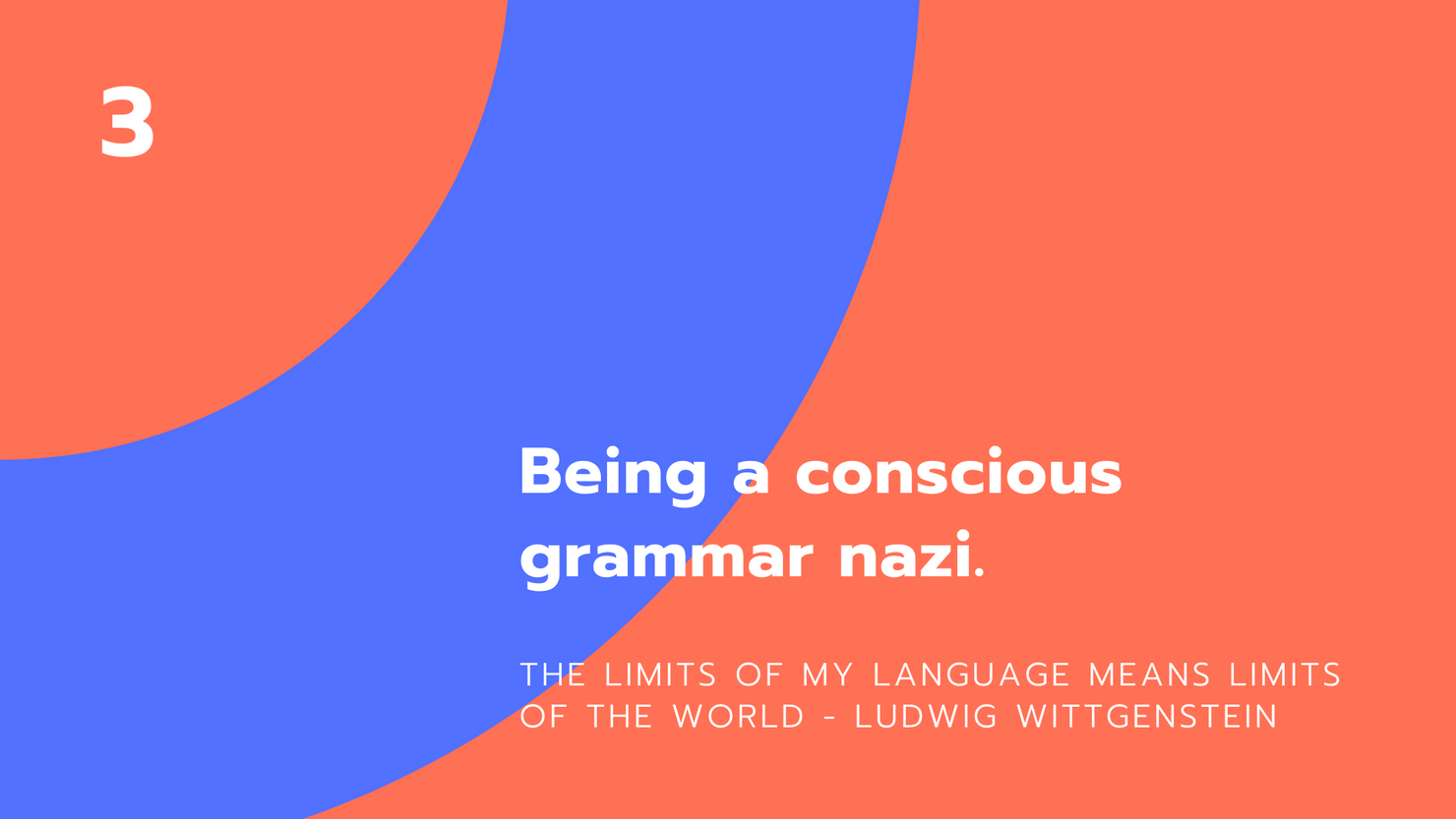
Framing of the words matters. And in the design process, it might become even more important to keep framing and reframing the problem until it makes sense in our context. For instance, when one is tackling an environmental issue, a slight change in the description of the problem from ‘climate change’ to ‘global warming’ could change the interpretations (George Lakoff, 2010) and the mental model related to it as well, thereby affecting the solutions that might come out of this eventually.

Choosing the right words. And choosing the words right. Both equally important in various governing aspects. For instance, mistaking an it’s for an its, or a you are for an you’re might just be the very thin line between being professional or being careless, which could eventually stifle a design agency. Collaboration between conscious grammar nazis becomes more productive, when we are busy involved with chasing meaningful outcomes rather than correcting spelling mistakes or punctuation marks.
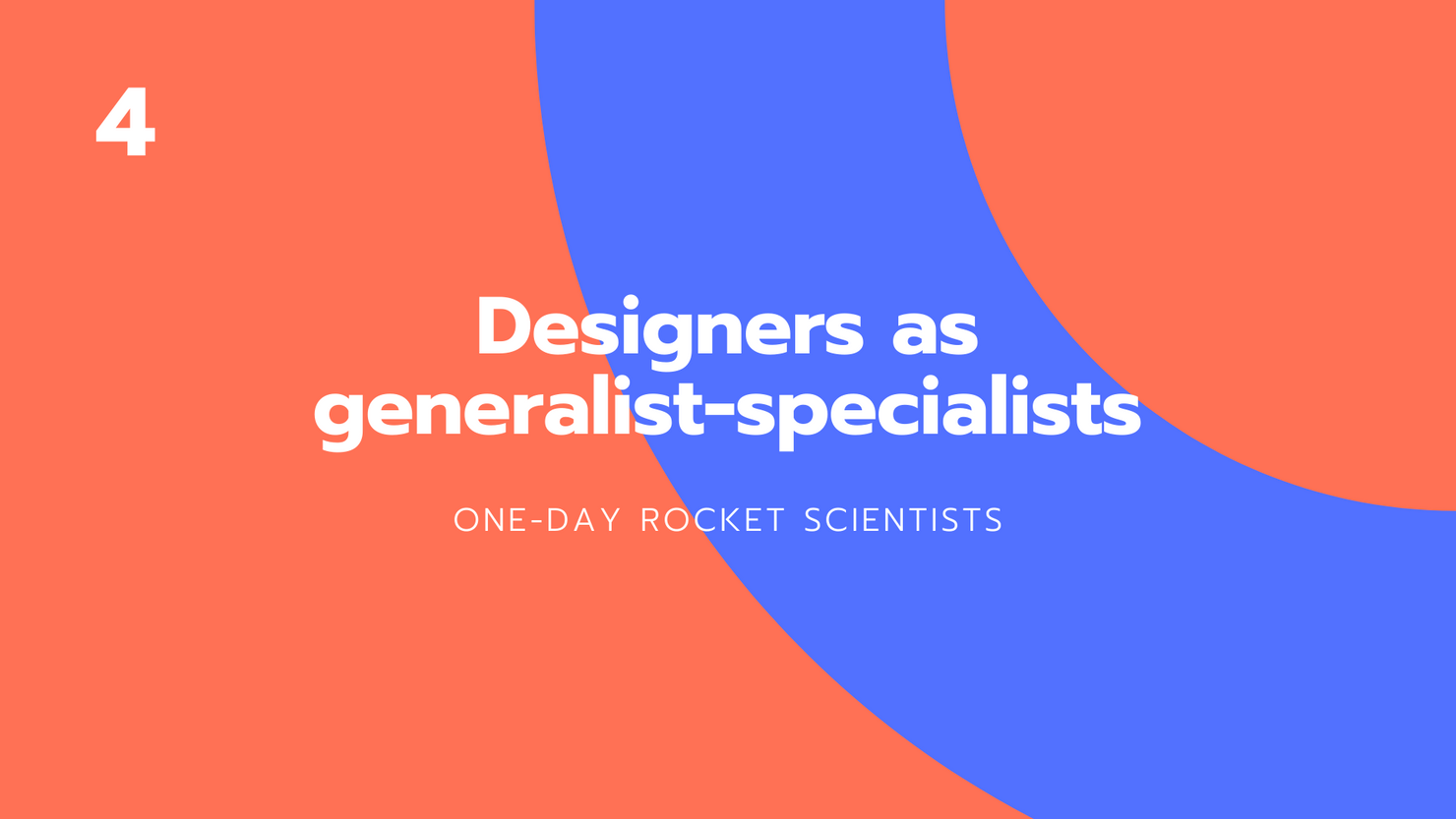
Designers don’t have to become rocket scientists to design rockets. There’s a big difference between design and science. Design has no right or wrong. No optimal answer to the problems. Where promising directions are taken in terms of designing services to products to both products and services together.
Coming back to the point, when designers come to a stage where they design rockets, my personal opinion is that they don’t have to know the exact science behind the rockets to design it.
Ashlee Vance, in the Elon Musk biography gives the example of how Musk cold-called a couple of Russian rocket scientists to have talks with them. Thereby absorbing experiences and knowledge from the people he was around, becoming the ‘one-day rocket scientist’ quite literally. This becomes an important quality as a designer especially when communicating with various specialists in different fields. The designer here is an interlocutor. And being a ‘generalist-specialist’ helps.
Even when it comes to designing rockets. Or anything else which involves technology or multi-level stakeholders. As the conversations could change from rocket propulsion to political strategies. It really depends on the context and one has to understand the vocabulary of the context.
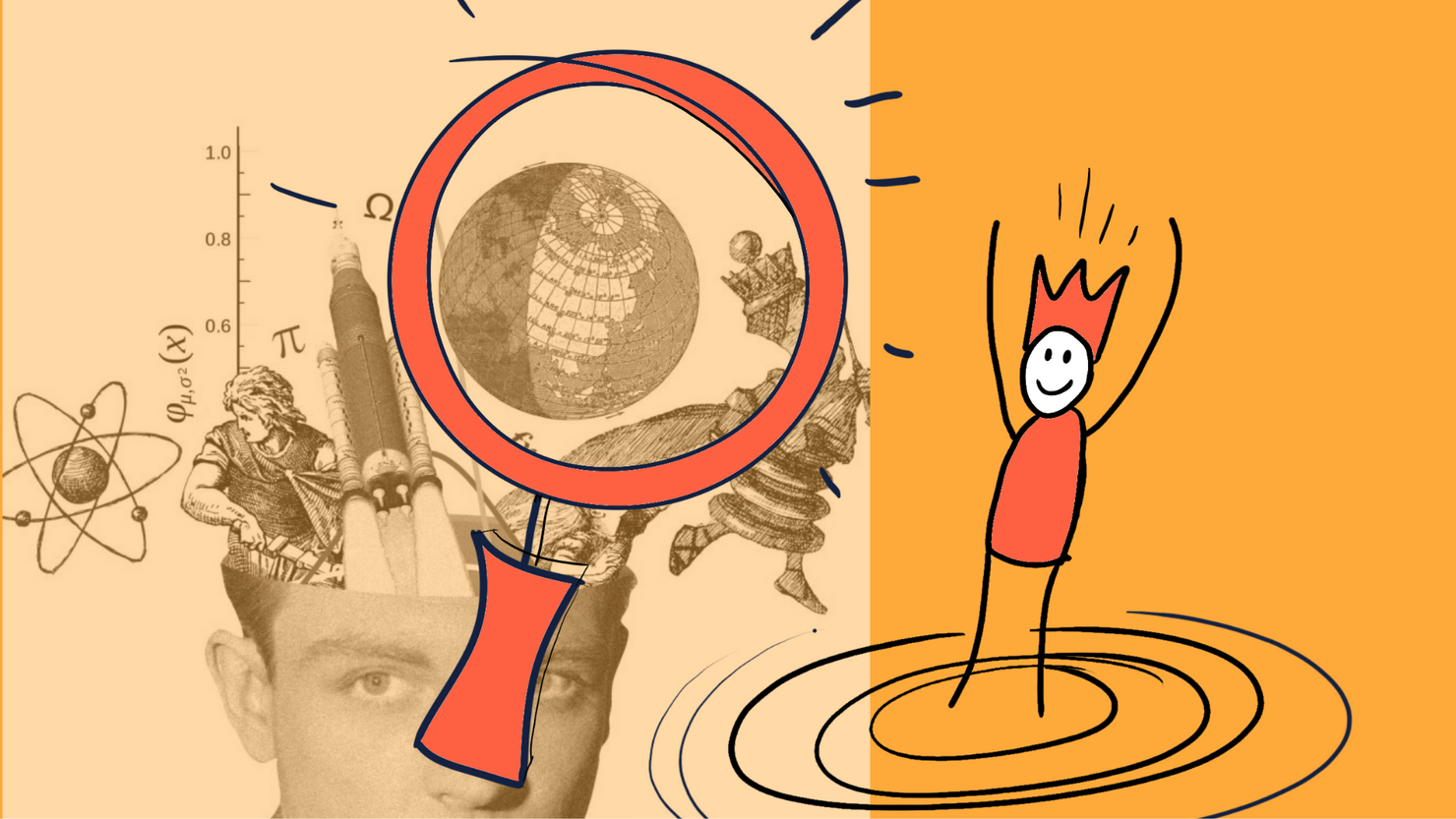
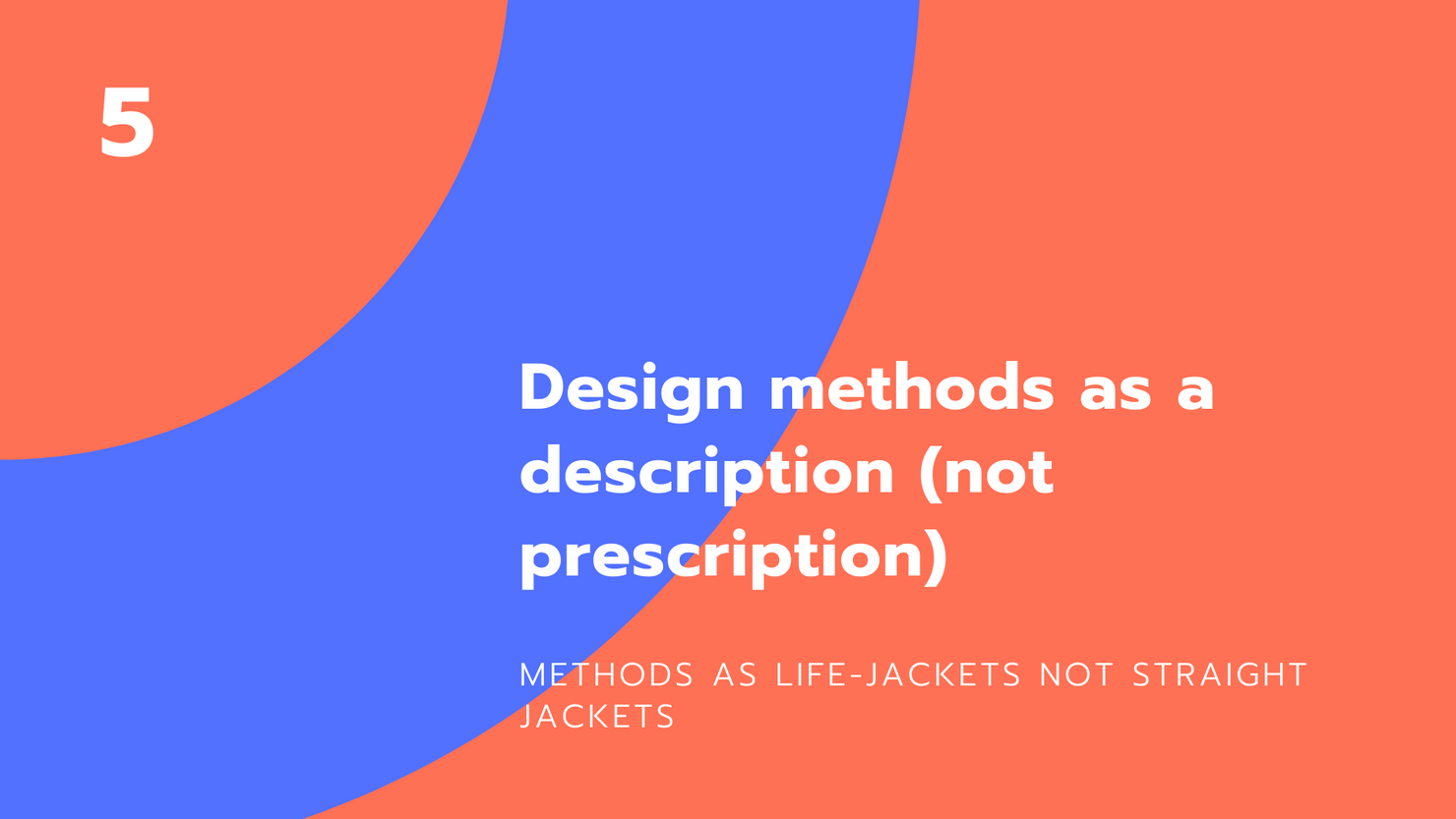
One might have usually encountered certain books existing as a compilation of various methods and methodologies (Delft Design Guide, Norbert Roozenberg etc) and it’s always a struggle to use the right method in the right situation.
When a certain method doesn’t work out as intended, we try to put the blame on the method or the facilitation of the process. Methods are sometimes incredibly useful, however, it should be looked at as a means to an end, but not as an end to itself. And while recommending methods to others, one should eat their own turtles. Or in other words, one should have skin-in-the-game, to have actually used it in practice and to recommend when one finds similar patterns from the past emerging in the current situation.
Therefore, they are a description of what one has executed in the past, and what could be applied, but not as a prescription. It can never be applied as a one-size-that-fits-all and one should always be skeptical about it.
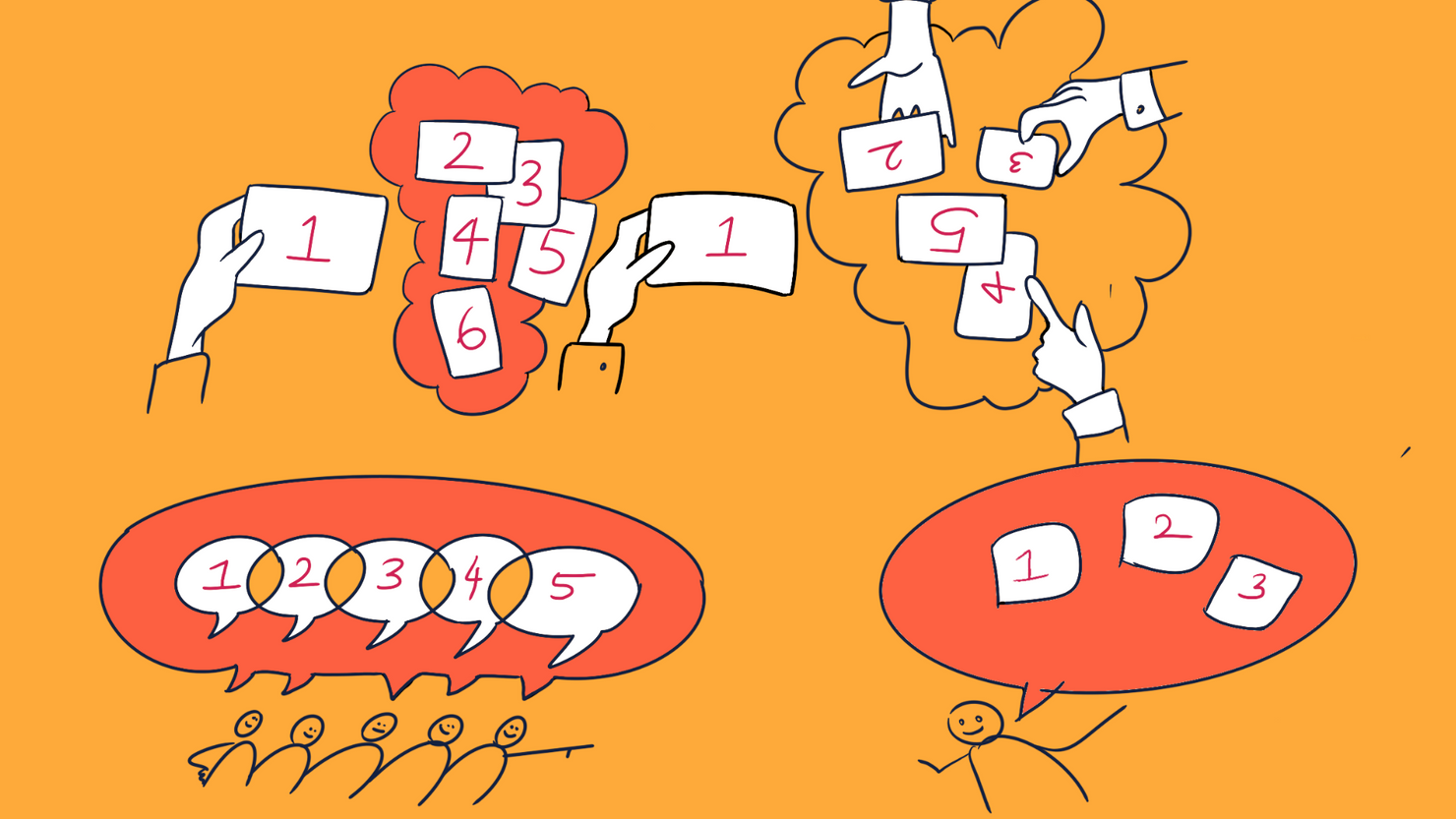
As Nigel Cross puts it in the paper (The Method in their madness, 1996), methods are life-jackets, helping designers out in fuzzy situations and not straight jackets, to be normally applied to each and every situation without thinking critically as to whether the method should be applied or not.
Methods help orchestrate the ‘madness’ of designers.
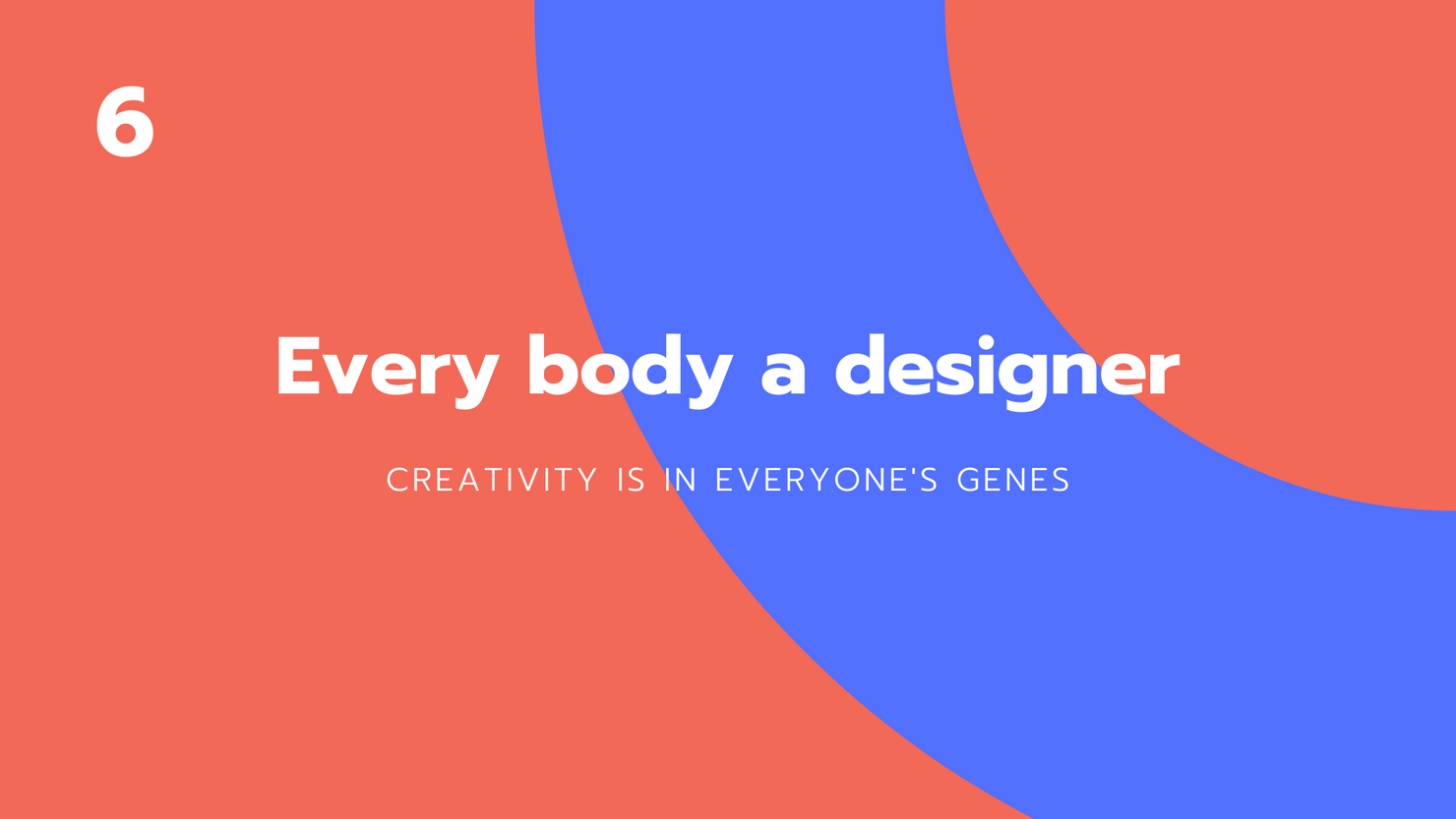
Every body a designer.
Every one can involve in the design process.
Be it Sporty Susan, or Political Pete and even Single Stella. By nature everyone is born creative, and creativity is not something exclusive to the profession of design. Ideas exist in the intersections. And that’s exactly some of the reasons why participation of key stakeholders in the design process can provide immense benefits. Direct users can provide key insights as ‘experts of experience’ whereas indirect users, or other stakeholders can help enriching the understanding of the problem by providing multi-fold vantage points.
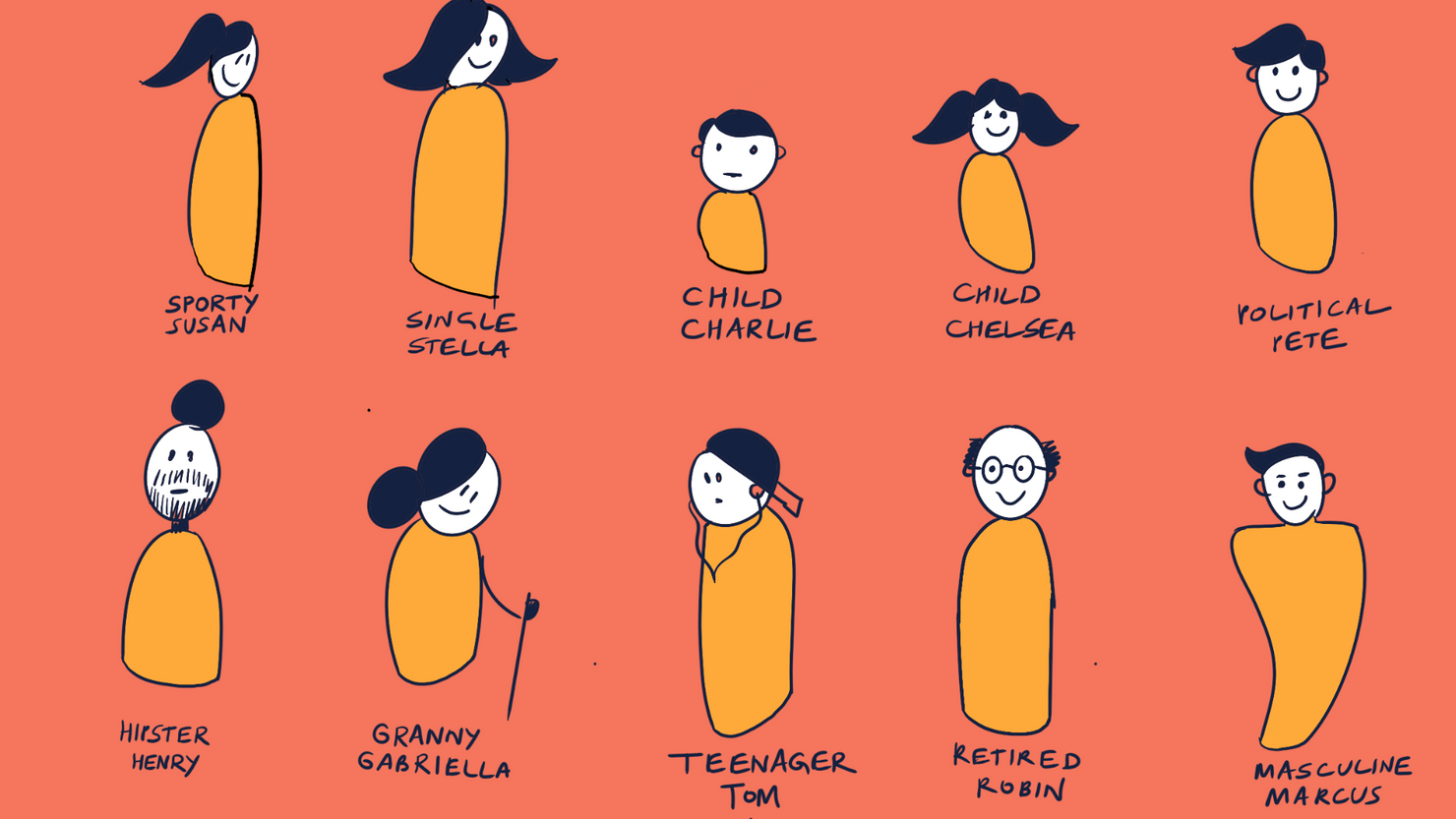
However, it has to be looked carefully in terms of application as collaboration might not necessarily lead to creative solutions if that’s what we’re looking for. But would definitely provide a better understanding of the problem. The analogy is similar to a blind man touching an elephant from various sides, and getting a better understanding of what one’s trying to perceive.
While involving stakeholders, the designer should play the role of a host at the dining table, carefully involving each participant with care and comfort as the best ideas come when at ease.

Prototypes should not be evaluated at its face value. But it has to be looked at as a tool for enquiry. As an investigation which sheds insights about the research question. In that regard, how beautiful the prototype would matter less if it doesn’t really help guide the research through design process (Rust, Chris. 2004)
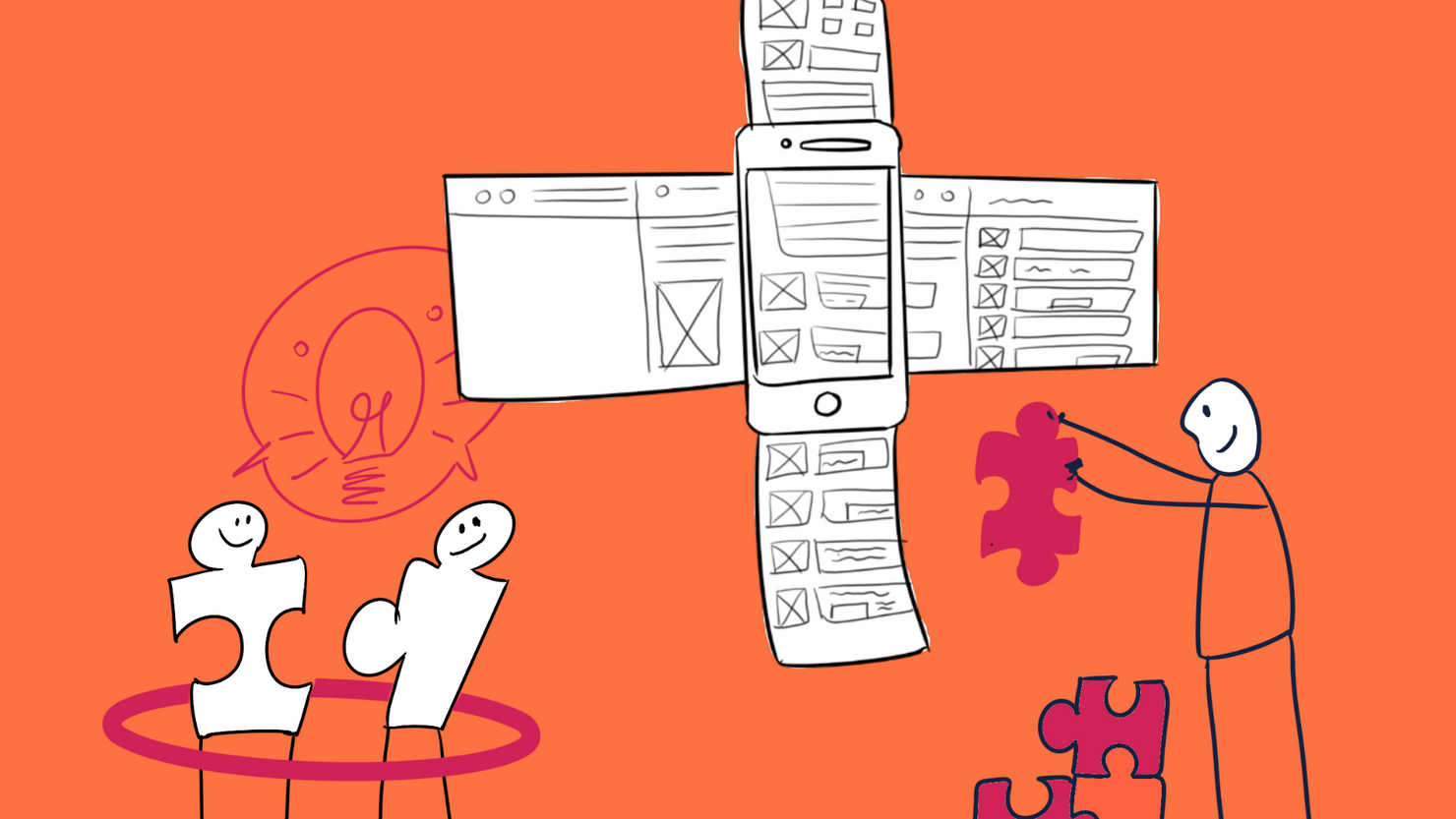

Prototypes need not exactly exist in a ‘physical’ space.
Einstein ran a series of visualised thought experiments for understanding physics better. Sometimes chasing beams of light mentally. On a similar note, prototypes need not be exactly demonstrated physically but could be done through role playing or through a series of thought experiments similar to how Einstein did. Qualities of the desired interaction could be demonstrated on the go without even a piece of paper. Just with your bare hands in a long train journey, one could iterate on the fly. That’s the power of an ultra-rapid prototype (Buchenau, 2000), when all you need is a chain-of-thought and some presence of mind.
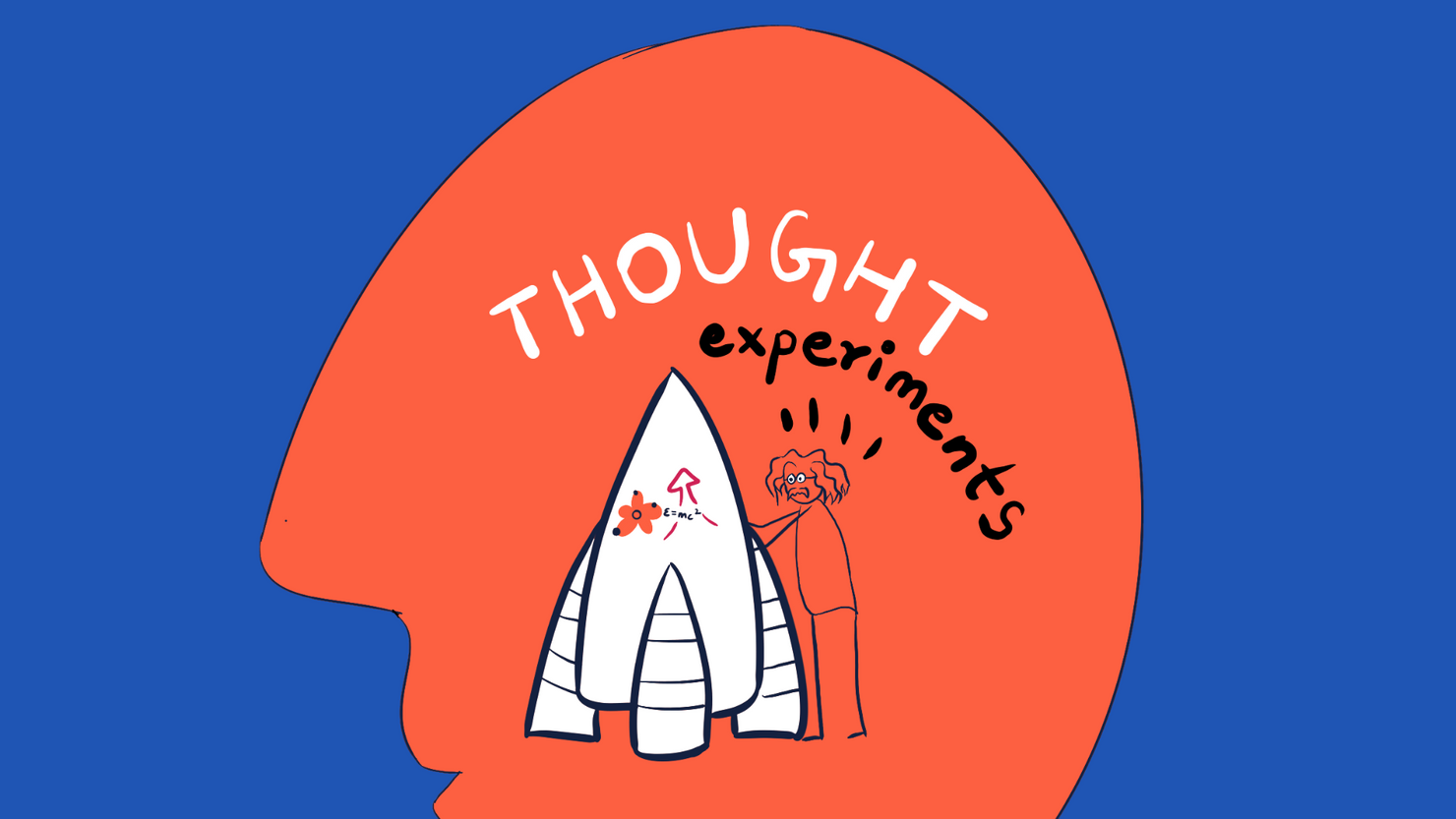

Being relaxed gives you more creative ideas. For Salvador Dali, it came at a specific junction in his sleep phase, while holding a steel ball in his hand waiting for it to fall so that he could wake up and sketch his ideas that pop up in his dreamy state. For some others, it can come while sitting naked in a bathtub (eureka, eureka!) or when waiting for your bus at the stop.

It no longer has to be forced upon by sitting in a cubicle, brainstorming various possibilities using different coloured sticky notes, but it could come through rational flaneuring (the act of walking without any specific direction or destination) or even through lucid dreaming.
The mind which has spent enough time digging into the root cause of the problem, the best ideas emerge in itself through the co-evolution of problem and the solution (Cross & Dorst, 2001)
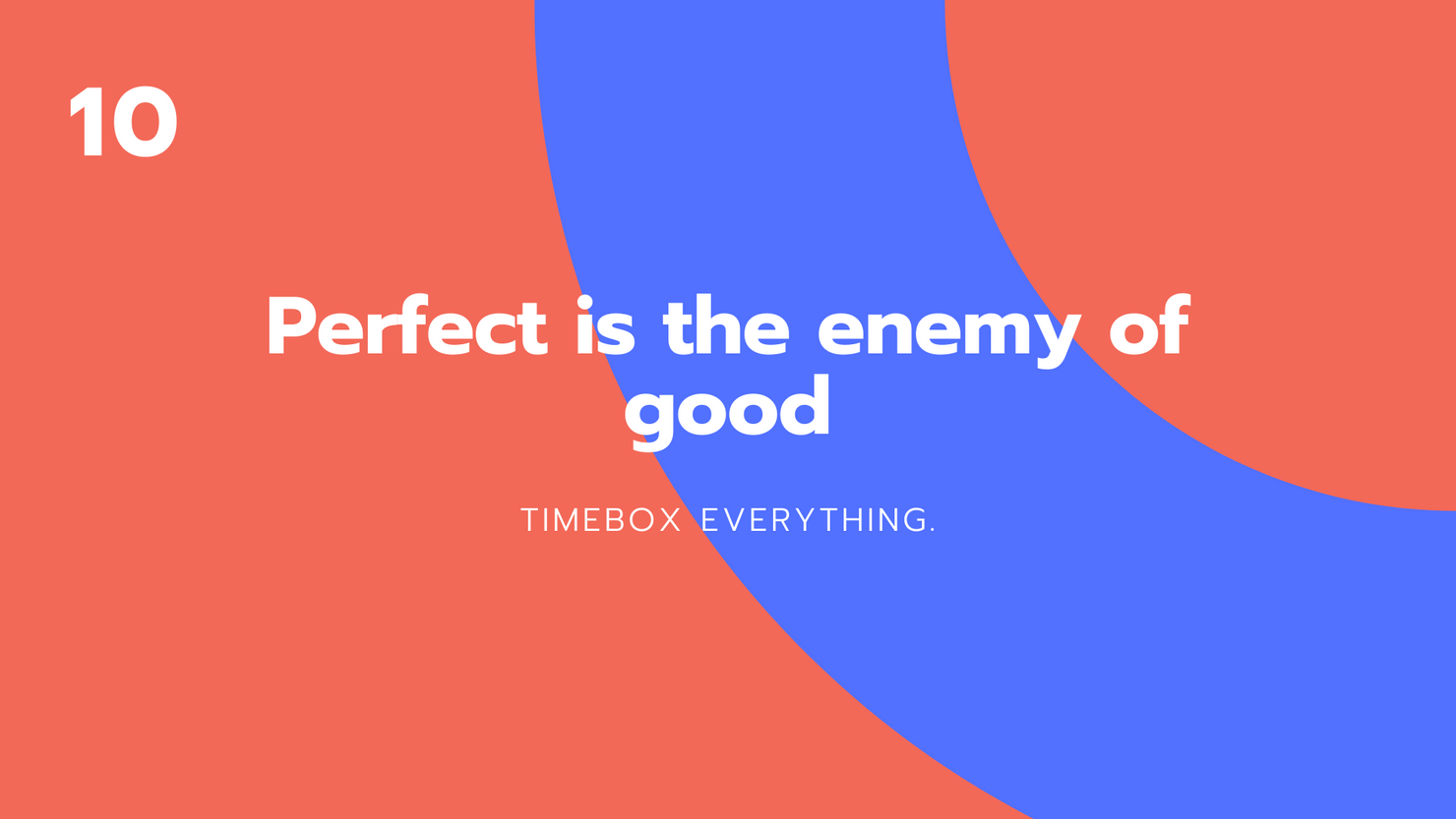
Perfect is the enemy of the good. What that means is that one could spend 100 hours on the same task which could probably be done with in 10 hours and be good enough.

Which is why Gert Hans, Founder of Scrum Academy suggests to timebox everything. 10 hours for the good job helps one to get closer to the goal than spending 100 hours for the perfect outcome.
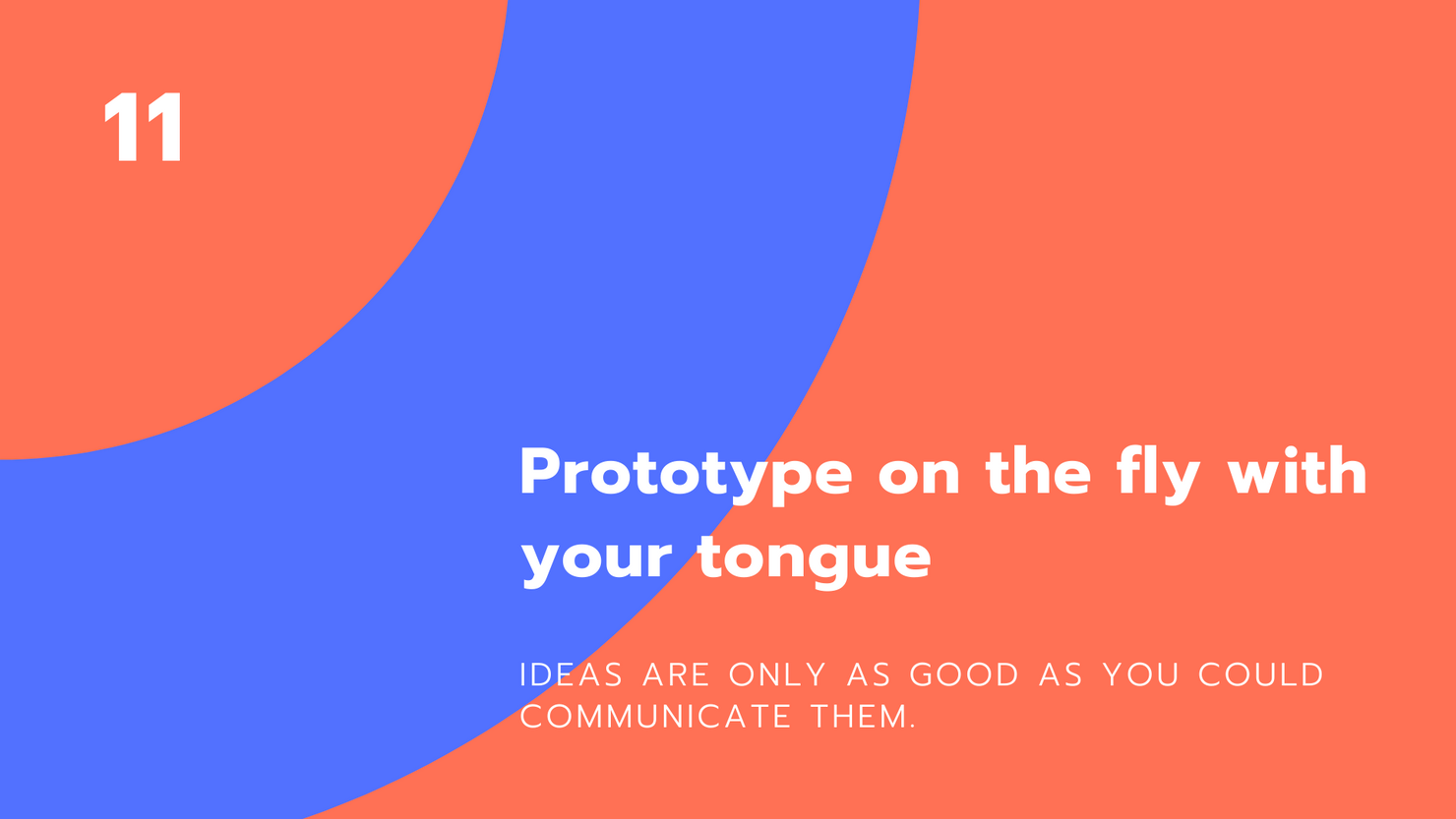
Viki Pavlic, Pitching coach from TU Delft regularly cites how Ideas are only as good as you could communicate them. Which is one of the reasons why verbal prototyping plays a major role - By finding the right words which conveys the desired reaction for the product/service. As you move from one person to another, through the verbal prototype, one gets feedback and iterates on the fly with ones tongue. Water cooler conversations which start with, ‘What are you working on?’ usually end with another iteration of the verbal prototype if looked this way. ^f04d25
What are you working on?
Iteration #1: I am designing an affordable, reliant device for deaf blind runners.
What are you working on?
Iteration #2: I am helping deaf blind runners navigate their surroundings using a communication device…
And so on.
Getting the words right matters.
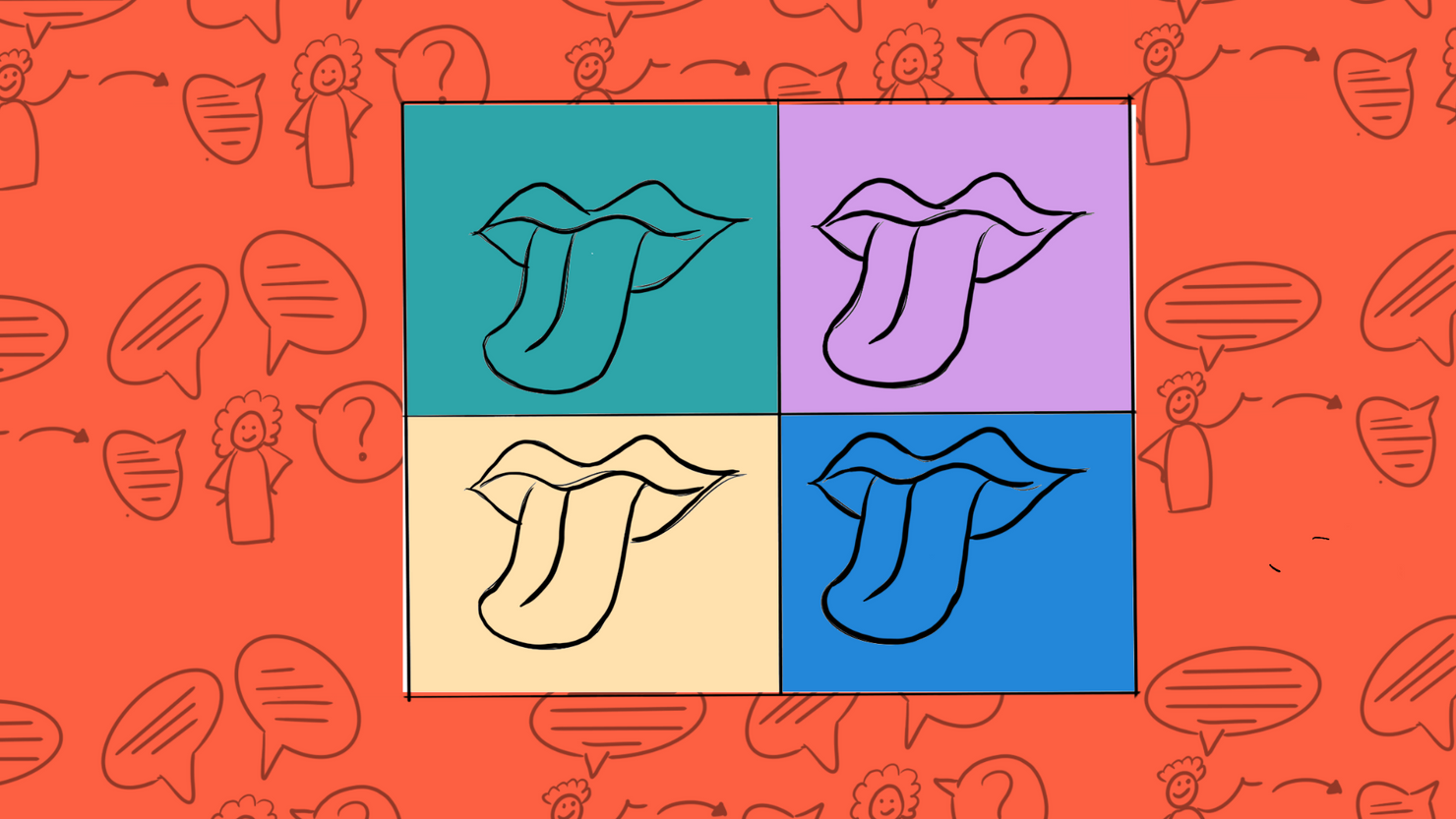
References
Lawson, B., & Dorst, K. (2009). Expertise in design. Design expertise, 81-112.
Lakoff, G. (2010). Why it matters how we frame the environment. Environmental Communication, 4(1), 70-81.
Dorst, K., & Cross, N. (2001). Creativity in the design process: co-evolution of problem–solution. Design studies, 22(5), 425-437.
Buchenau, M., & Suri, J. F. (2000, August). Experience prototyping. In Proceedings of the 3rd conference on Designing interactive systems: processes, practices, methods, and techniques (pp. 424-433).
Willemien Brand. (2017) Visual Thinking: Empowering People and Organisations Through Visual Collaboration
